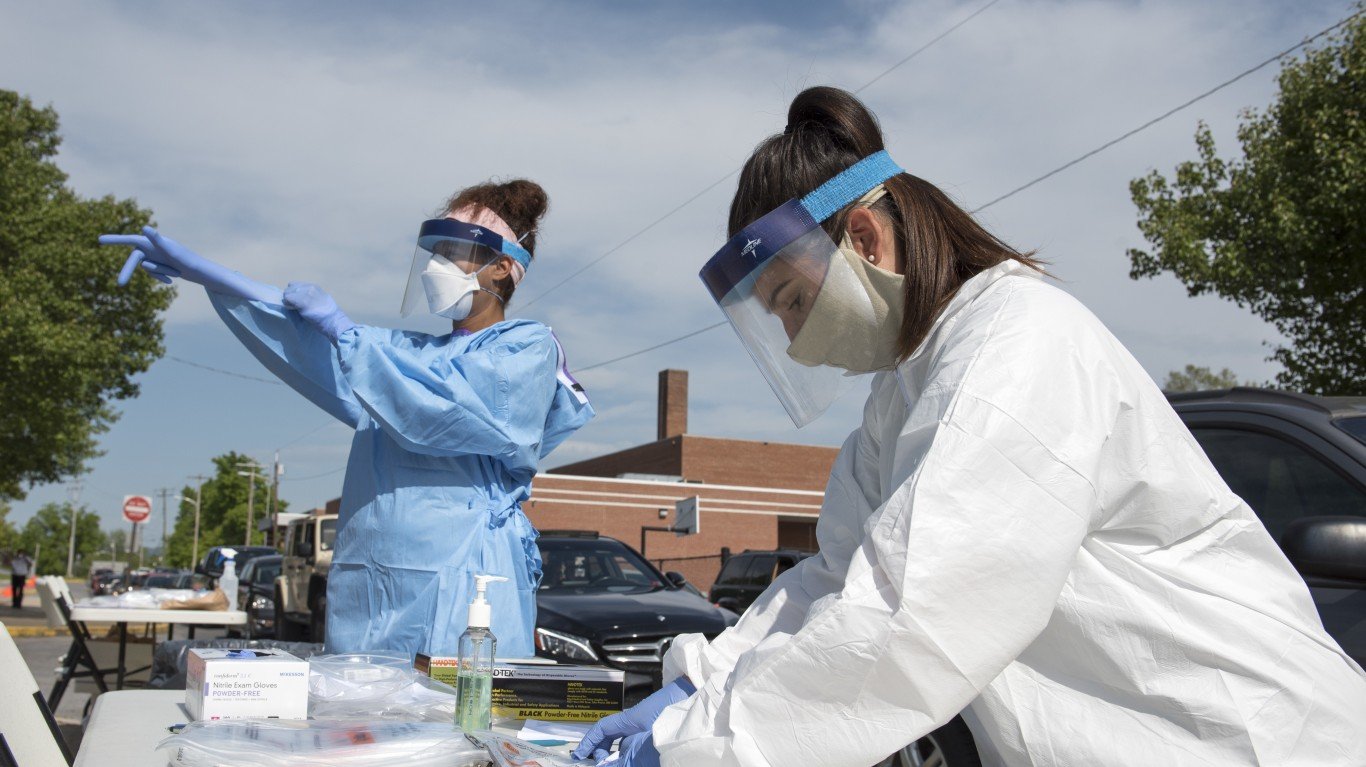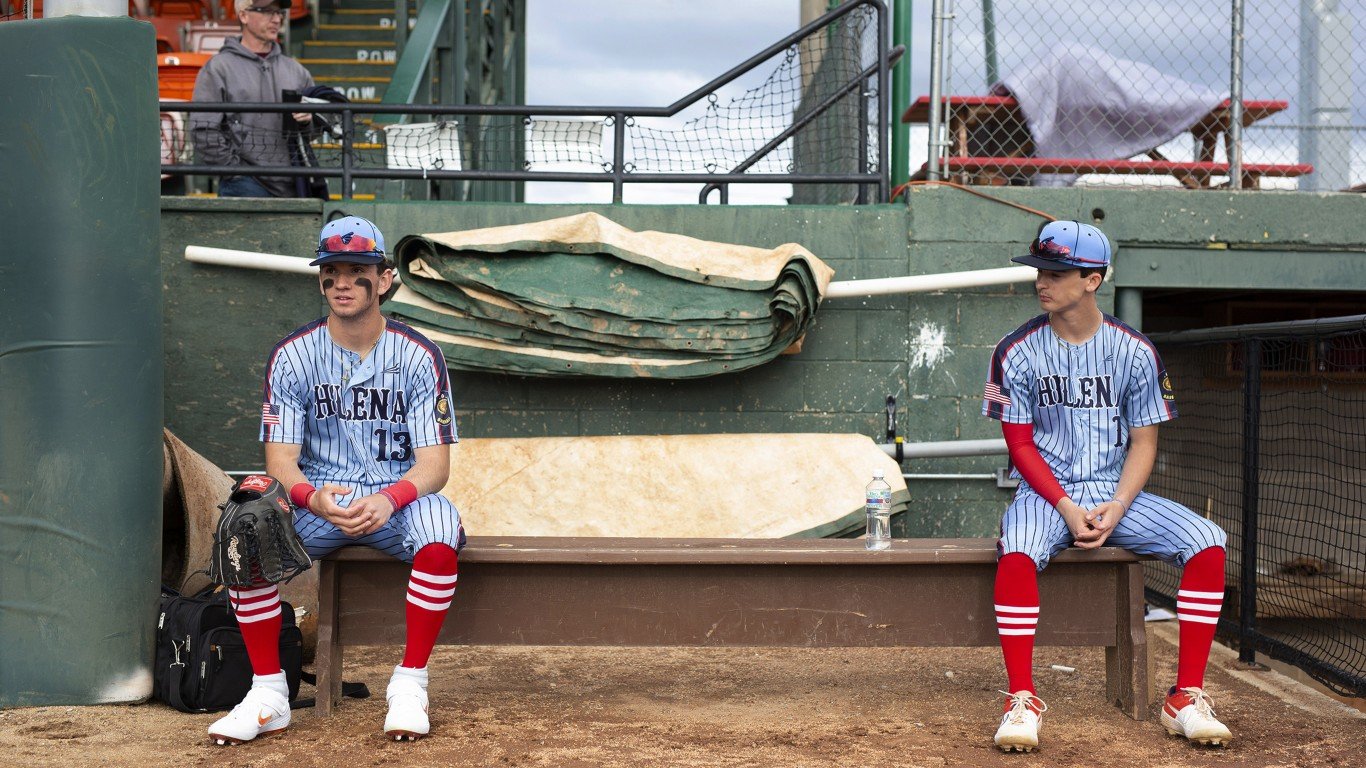

The U.S. reported a record number of new coronavirus cases, with over a million new cases recorded since the beginning of June. Spikes in new COVID-19 cases have been reported in most states across the country in recent weeks. Many states are taking action and are halting plans for further reopening.
To determine each state’s social distancing measures and rules for reopening, 24/7 Wall St. reviewed executive orders from state governors over the last few weeks.
No states are considering, at least as of yet, an option to return to a complete shutdown. But more states are mandating that people wear masks when they are anywhere in public, especially in enclosed spaces.
As the country reached another sad milestone in the age of COVID-19, surpassing 3 million cases on July 8, there are significant variations in how states are deciding to continue opening their economies and allow people to gather again.
The death toll from the coronavirus disease has climbed to nearly 134,000 as of July 9. The concentrations of active cases are not evenly spread across the country, and the hotspots of the virus are changing — these are the states where the coronavirus is growing the fastest right now.
Click here to see every state’s rules for staying open and social distancing
Alabama
> Cumulative COVID-19 cases as of July 9: 950 per 100,000 people — 17th highest (total: 46,424)
> COVID-19-related deaths as of July 9: 21 per 100,000 people — 23rd highest (total: 1,032)
> Total tests administered as of July 9: 9,570 per 100,000 people — 23rd lowest (total: 467,754)
> Change in trailing 7-day avg. daily cases, June 1 – July 8: 20.8% — 15th biggest increase (from 38,442 to 46,424)
> Population: 4,887,871
Until July 3, Alabama was under a Safer at Home order, which allowed restaurants to offer food for takeout and delivery. Customers must maintain 6-foot social distancing protocols. Entertainment venues, such as arcades, movie theaters, and bowling alleys are also allowed to open, but there must be no waiting lines, people have to wear masks, and customers have to be separated by at least 6 feet. Sports practices resumed May 23, and games have been allowed to take place after June 15.
Schools in Alabama were allowed to reopen on June 1, and students and teachers need to maintain 6 feet social distancing. Employees at educational institutions are required to wear masks. There is no statewide mandate to wear masks, though some counties are making face coverings a requirement when people are in public places.
[in-text-ad]
Alaska
> Cumulative COVID-19 cases as of July 9: 166 per 100,000 people — 3rd lowest (total: 1,226)
> COVID-19-related deaths as of July 9: 2 per 100,000 people — 3rd lowest (total: 17)
> Total tests administered as of July 9: 18,090 per 100,000 people — 5th highest (total: 133,401)
> Change in trailing 7-day avg. daily cases, June 1 – July 8: 25.4% — 9th biggest increase (from 978 to 1,226)
> Population: 737,438
Travelers arriving into Alaska from another state or country now have to follow new protocols. They must complete a traveler declaration form and either present results of a negative COVID-19 test taken within the previous 72 hours or take a test upon arrival and self-quarantine until results are known. Travelers can only use road or maritime highways, and travel to remote areas is restricted to essential travel.
Alaska is in phase 3 of reopening. All businesses (in full capacity), religious gatherings, libraries, museums, recreational activities, and sport activities can open.
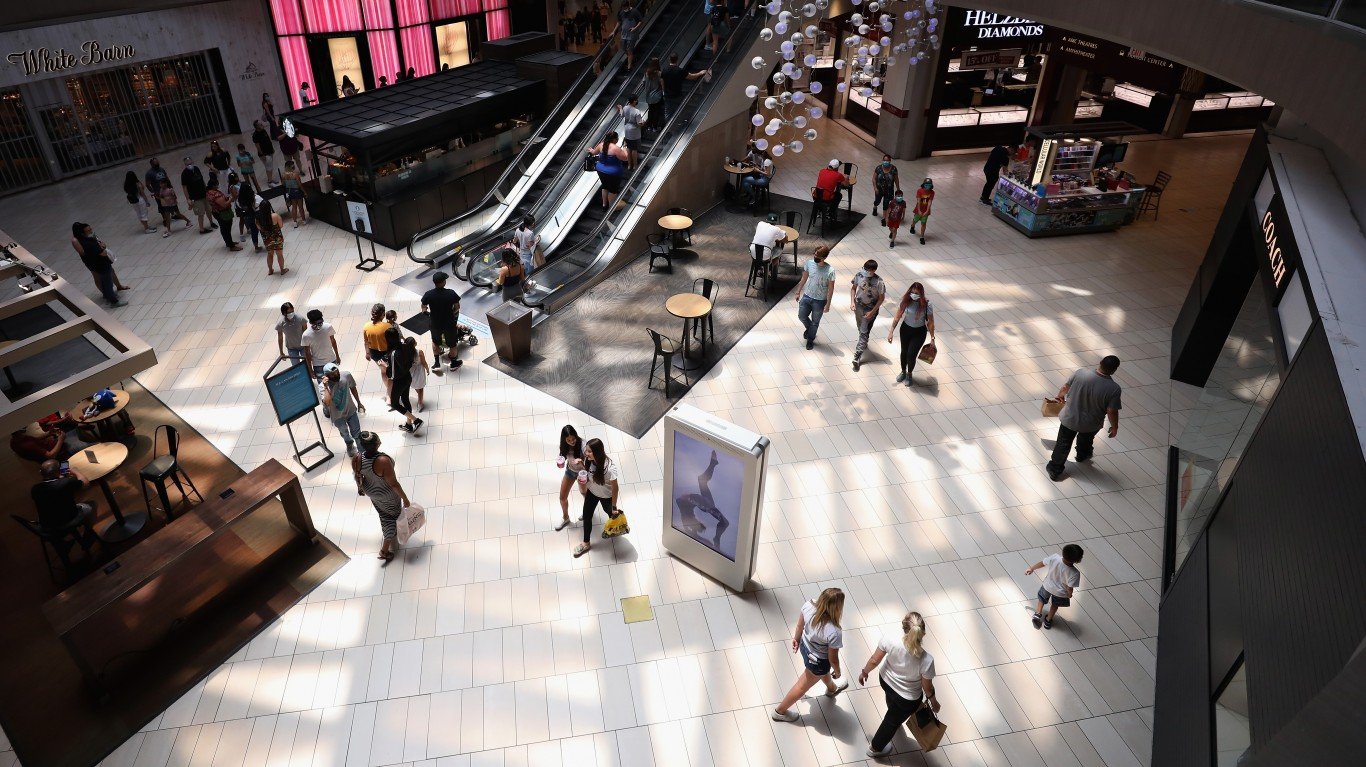
Arizona
> Cumulative COVID-19 cases as of July 9: 1,514 per 100,000 people — 5th highest (total: 108,614)
> COVID-19-related deaths as of July 9: 27 per 100,000 people — 17th highest (total: 1,963)
> Total tests administered as of July 9: 8,931 per 100,000 people — 19th lowest (total: 640,487)
> Change in trailing 7-day avg. daily cases, June 1 – July 8: 29.2% — 5th biggest increase (from 84,092 to 108,614)
> Population: 7,171,646
Arizona is among the states where COVID-19 cases have been surging in recent weeks. Gov. Doug Ducey issued an executive order on June 29 that prohibits gatherings of more than 50 people. Bars, gyms, movie theaters, water parks, and tubing rentals are closed, again, for a month. The first day of school for in-person instruction has been delayed to August 17.
Businesses are required to keep employees and customers at least 6 feet apart and to demand all in the business to wear face covering whenever possible. There is no statewide requirement for people to wear masks, but local governments can implement their own mask and face covering policies and determine enforcement.
Arkansas
> Cumulative COVID-19 cases as of July 9: 838 per 100,000 people — 19th highest (total: 25,246)
> COVID-19-related deaths as of July 9: 10 per 100,000 people — 14th lowest (total: 305)
> Total tests administered as of July 9: 11,909 per 100,000 people — 18th highest (total: 358,917)
> Change in trailing 7-day avg. daily cases, June 1 – July 8: 15.6% — 21st biggest increase (from 21,197 to 24,512)
> Population: 3,013,825
Arkansas entered phase 2 of reopening on June 15. Restaurants and other businesses can now expand to two-thirds capacity, up from a third of capacity under phase 1. Summer day camps are open. but class sizes are limited to no more than 10 people. Camp enrollment is limited in order to allow proper physical distancing.
High school and community sports teams were allowed to resume practice events starting June 1, under strict measures. Gov. Asa Hutchinson postponed in-person graduation ceremonies until at least July 1. Short-term rentals such as hotels, motels, and vacation rentals are limited to “authorized guests,” which include national guard members, first responders, homeless people, and journalists. Long-term care facilities such as nursing homes may resume limited visitation after July 1.
[in-text-ad-2]
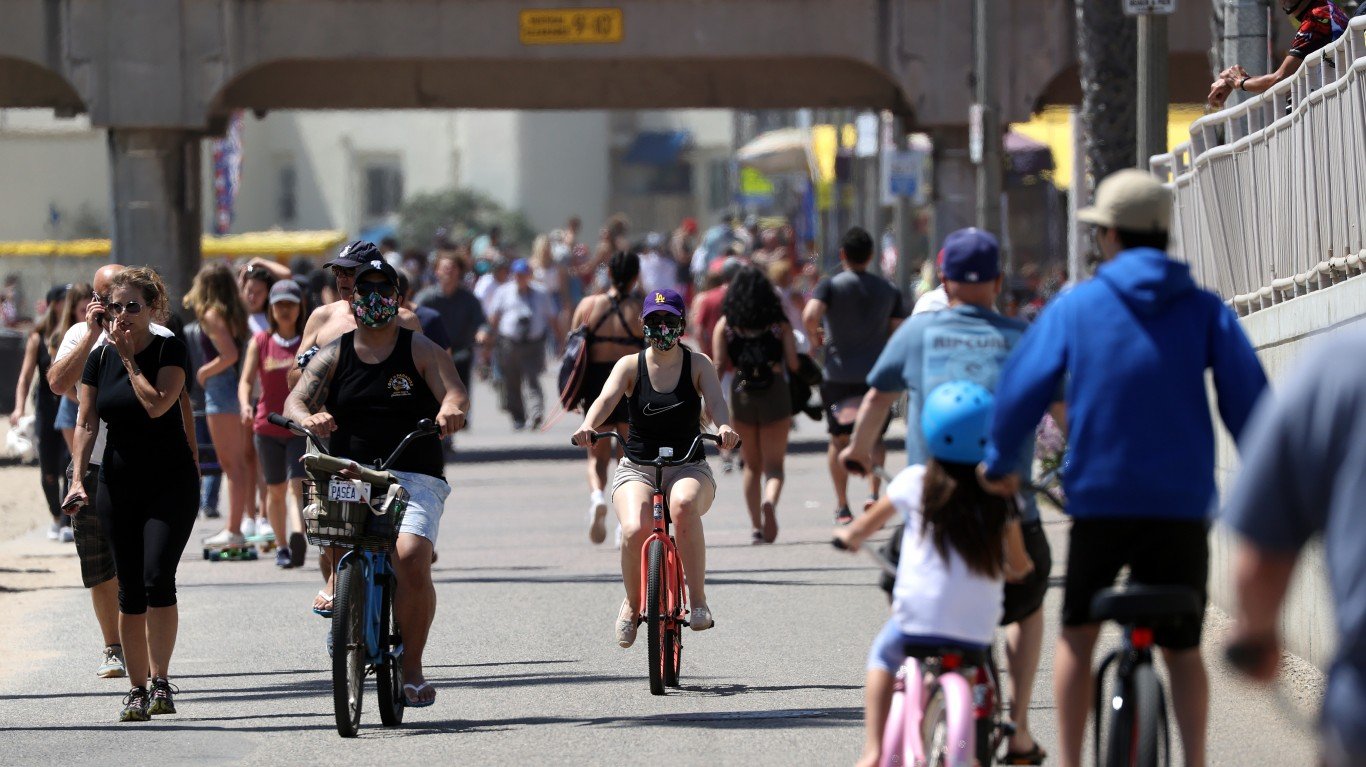
California
> Cumulative COVID-19 cases as of July 9: 732 per 100,000 people — 23rd lowest (total: 289,468)
> COVID-19-related deaths as of July 9: 17 per 100,000 people — 22nd lowest (total: 6,562)
> Total tests administered as of July 9: 12,630 per 100,000 people — 14th highest (total: 4,996,175)
> Change in trailing 7-day avg. daily cases, June 1 – July 8: 24.4% — 10th biggest increase (from 232,657 to 289,468)
> Population: 39,557,045
A stay-at-home order, which has no set end date, is still in effect, though some restrictions have already been lifted. New coronavirus cases have been surging over the last few weeks. As a result, Gov. Gavin Newsom announced on July 1 that in 19 counties, restaurants, wineries, movie theaters, zoos, museums, and card rooms have to stop all indoor operations. Bars must shut down completely. Since July 1, several more counties have been added to the list.
To flatten the curve, Californians must wear masks or other face coverings while in public or in high-risk places such as stores, public transit, or hospitals.The state is reopening at the county level, with counties that meet specific criteria allowed to lift certain restrictions.
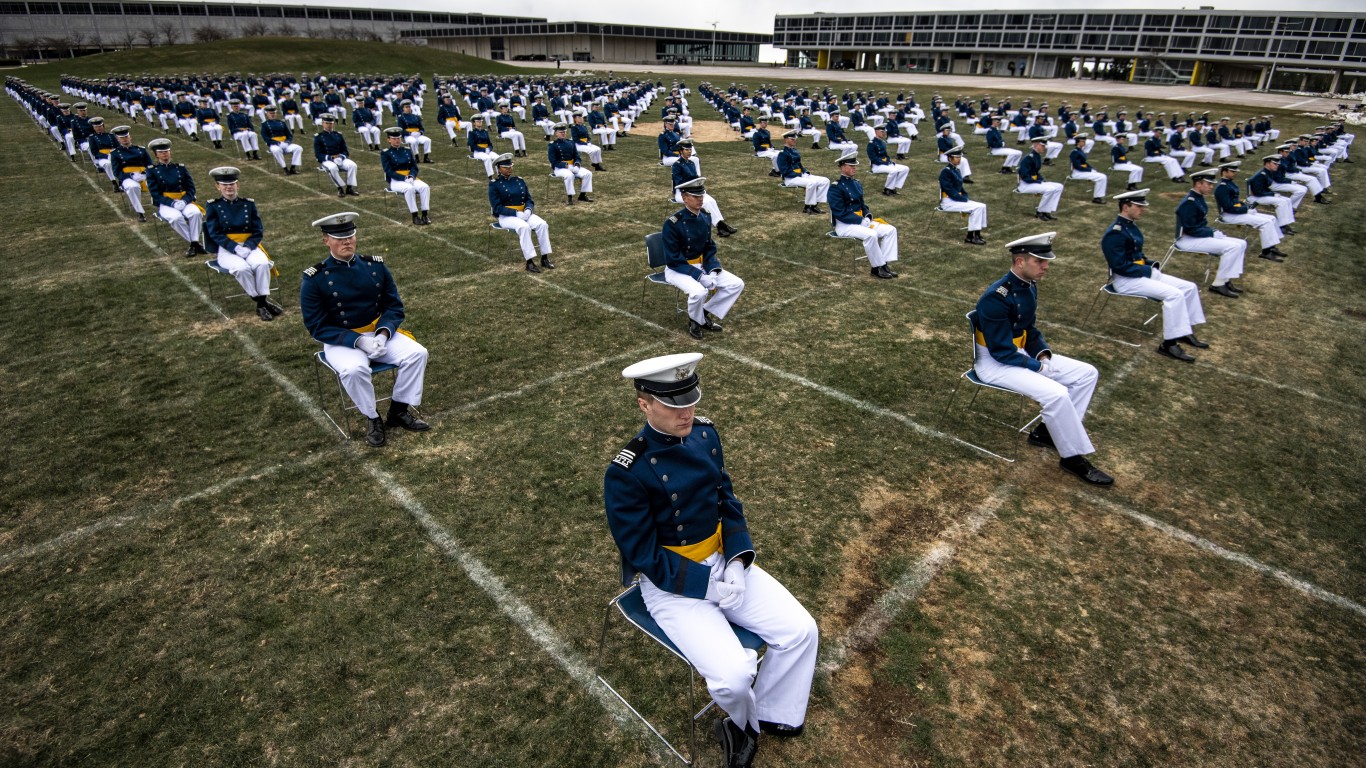
Colorado
> Cumulative COVID-19 cases as of July 9: 617 per 100,000 people — 19th lowest (total: 35,116)
> COVID-19-related deaths as of July 9: 30 per 100,000 people — 14th highest (total: 1,704)
> Total tests administered as of July 9: 6,456 per 100,000 people — 8th lowest (total: 367,724)
> Change in trailing 7-day avg. daily cases, June 1 – July 8: 6.0% — 14th smallest increase (from 32,715 to 34,664)
> Population: 5,695,564
Gov. Jared Polis signed an order on June 1 shifting Colorado to a Safer at Home and in the Vast, Great Outdoors order from the previous Safer at Home order. The new order now encourages people to go outside while maintaining social distancing. Playgrounds and swimming pools are allowed to open at limited capacity.
Bars have been ordered to close, except those that have taken steps to open as restaurants and have customers sit 6 feet apart. All activities and social gatherings are allowed but at 50% of pre-pandemic capacity with people being at least 6 feet apart or at no more than 500 people in one setting at a time.
[in-text-ad]
Connecticut
> Cumulative COVID-19 cases as of July 9: 1,319 per 100,000 people — 7th highest (total: 47,108)
> COVID-19-related deaths as of July 9: 122 per 100,000 people — 3rd highest (total: 4,343)
> Total tests administered as of July 9: 14,988 per 100,000 people — 8th highest (total: 535,465)
> Change in trailing 7-day avg. daily cases, June 1 – July 8: 1.0% — the smallest increase (from 46,646 to 47,108)
> Population: 3,572,665
Connecticut announced that summer camps have been allowed to open since June 29, in compliance with state requirements. As of June 1, barbershops, hair salons, and tribal casinos were allowed to reopen. Gov. Ned Lamont’s order on limits on social gatherings was amended, and as of June 1, outdoor gatherings of up to 25 people were allowed, in compliance with social distancing protocols of 6 feet apart and wearing of masks. As of June 2, child care facilities have been allowed to have 50 kids, up from 30. And since July 6, outdoor and in-person graduation ceremonies can be held. State campgrounds opened for the season on July 8. Campers were able to make reservations online beginning June 20. The state’s two river ferry services resumed on June 20.
Connecticut is one of several states that now require people coming from states with a 10% positivity rate in daily COVID-19 testing or higher to self-isolate for two weeks.
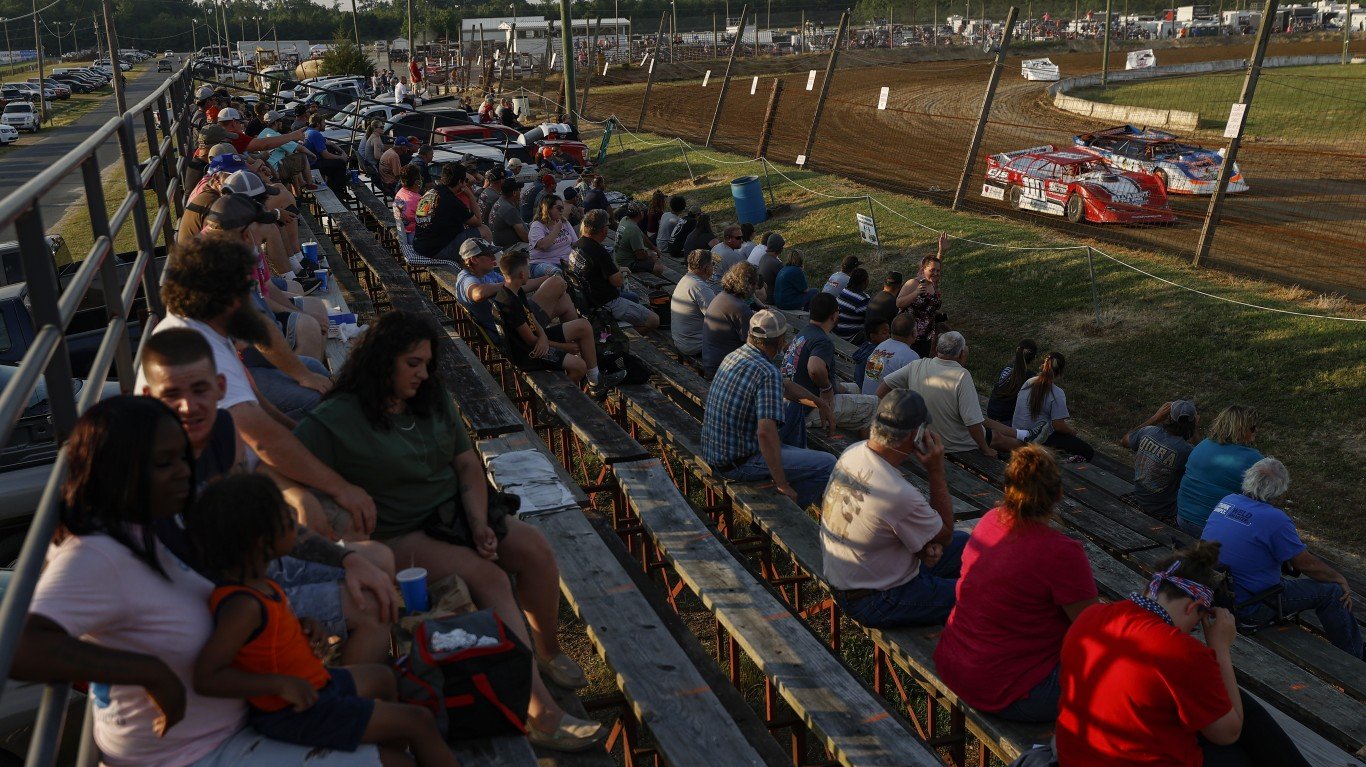
Delaware
> Cumulative COVID-19 cases as of July 9: 1,289 per 100,000 people — 8th highest (total: 12,462)
> COVID-19-related deaths as of July 9: 53 per 100,000 people — 10th highest (total: 515)
> Total tests administered as of July 9: 13,341 per 100,000 people — 11th highest (total: 129,034)
> Change in trailing 7-day avg. daily cases, June 1 – July 8: 6.2% — 16th smallest increase (from 11,731 to 12,462)
> Population: 967,171
Delaware has been in phase 2 of reopening since June 15. Phase 3 was supposed to begin on June 29 but was delayed. Retail stores, restaurants, and other businesses can open at 60% capacity, up from 30% during phase 1. Child care facilities are allowed to open for all families, not just children of essential workers, with group size limits. People are urged to continue working from home if possible. Personal care services such as massage therapy are now allowed to reopen at 60% capacity.
Outdoor gatherings are allowed but with no more than 250 people. Recreational sports tournaments can resume. People are required to wear face coverings in public settings, including stores, doctor’s offices, and public transportation.
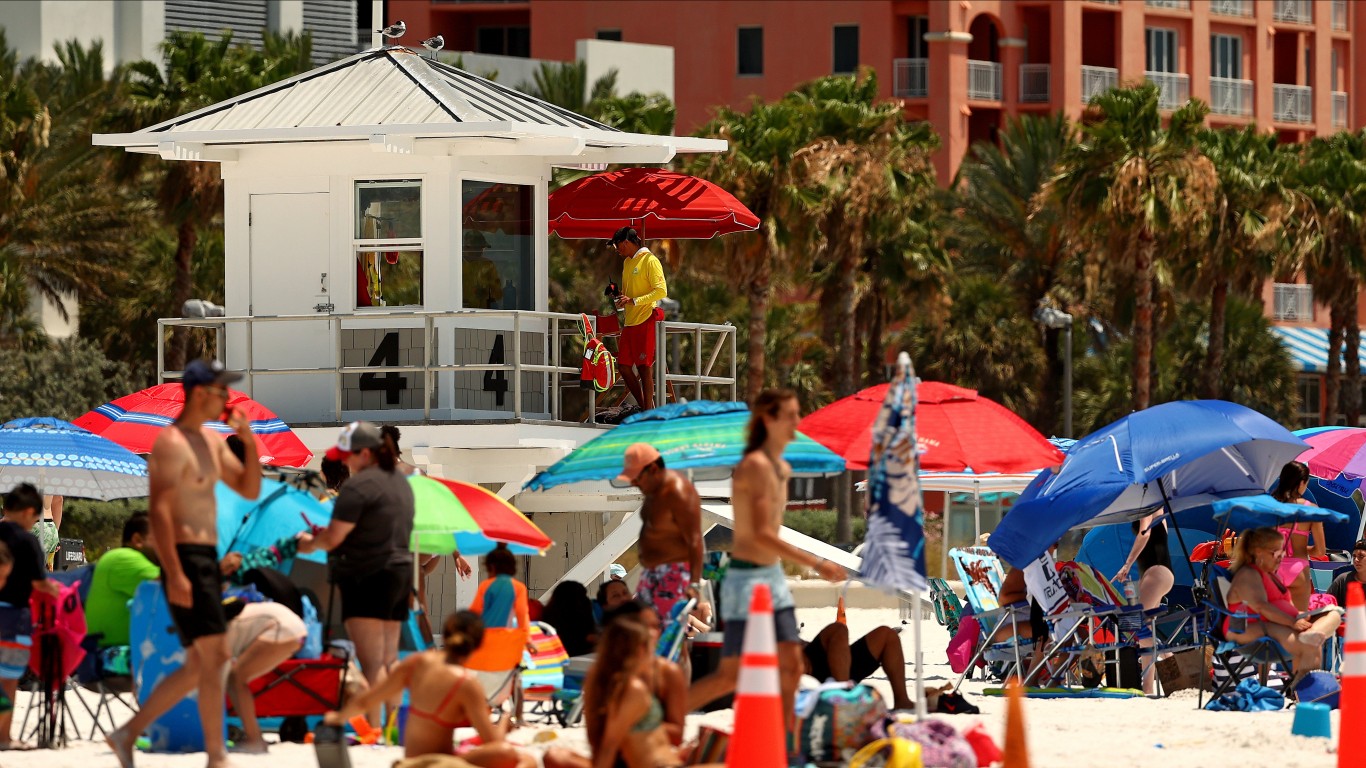
Florida
> Cumulative COVID-19 cases as of July 9: 1,093 per 100,000 people — 12th highest (total: 232,718)
> COVID-19-related deaths as of July 9: 19 per 100,000 people — 24th highest (total: 4,009)
> Total tests administered as of July 9: 11,078 per 100,000 people — 20th highest (total: 2,359,636)
> Change in trailing 7-day avg. daily cases, June 1 – July 8: 40.7% — the biggest increase (from 158,997 to 223,783)
> Population: 21,299,325
Phase 2 of the reopening of Florida’s economy began on June 3. Under phase 2, bars and pubs may operate dine-in service at 50% capacity inside and full capacity outside. Movie theaters and entertainment venues can operate at 50% capacity also. There are restrictions on salons and barbershops. All Florida counties, except Miami-Dade, Broward, and Palm Beach, entered phase 2 on June 5.
The state has yet to set a date for the start of phase 3, when bars, restaurants, gyms, and other businesses will be able to resume operations at full capacity and when sporting events will be open for fans. Florida has to have a downward trend of new coronavirus cases before phase 3 is implemented. This may not happen soon as the state is experiencing a surge of COVID-19 cases, with young people comprising most of the new positive tests. People are asked to gather in groups of no more than 50 people.
[in-text-ad-2]
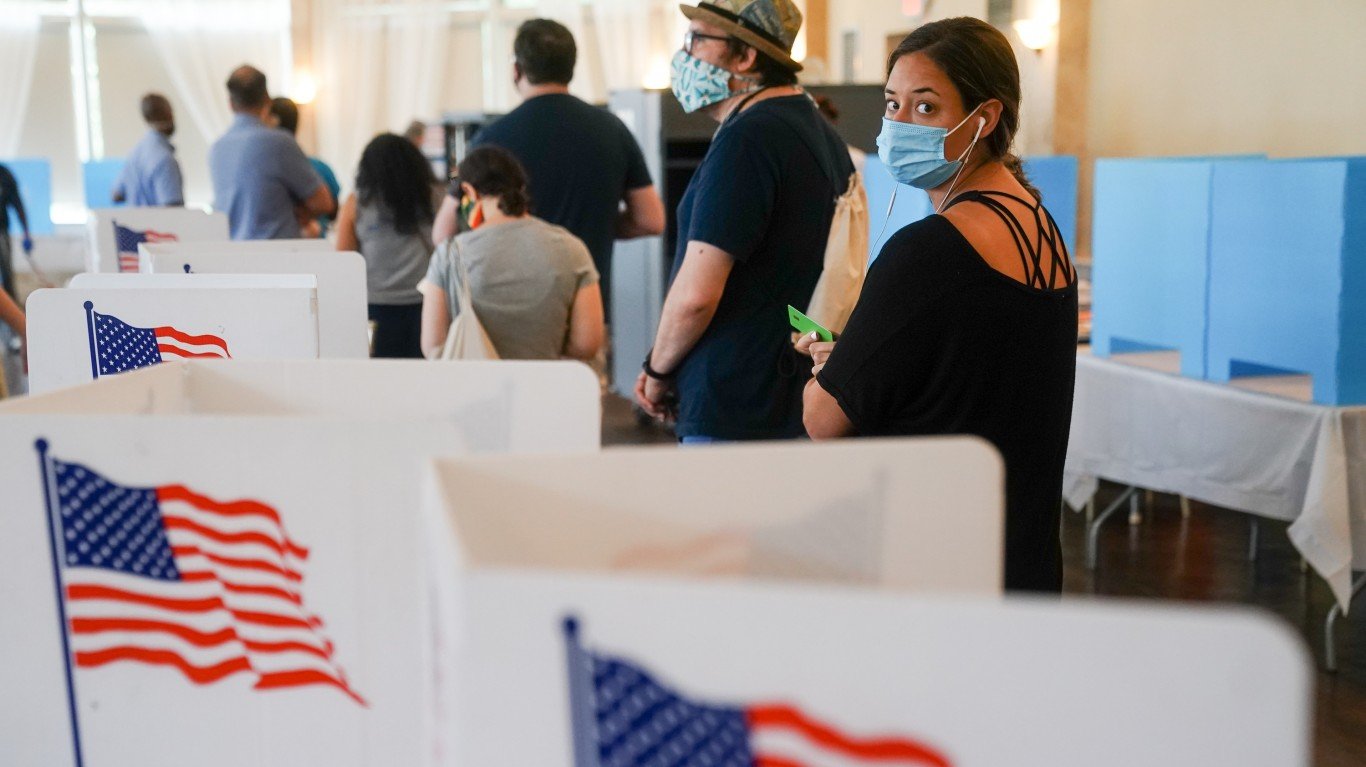
Georgia
> Cumulative COVID-19 cases as of July 9: 988 per 100,000 people — 15th highest (total: 103,890)
> COVID-19-related deaths as of July 9: 28 per 100,000 people — 16th highest (total: 2,922)
> Total tests administered as of July 9: 9,510 per 100,000 people — 21st lowest (total: 1,000,409)
> Change in trailing 7-day avg. daily cases, June 1 – July 8: 22.3% — 13th biggest increase (from 84,967 to 103,890)
> Population: 10,519,475
The general shelter-in-place order expired on April 30, and the shelter-in-place order for older state residents and other at-risk individuals expired on June 12. Most social gatherings of more than 50 people are banned, unless there can be 6 feet of distance between every person. Gov. Brian Kemp permitted amusement park rides, carnivals, circuses, and water parks to open beginning June 12 in compliance with health requirements. Restaurants no longer have a limit on how many people can sit at one table or on the number of customers per square foot. Bars can now have 50 people or 35% of full capacity, whichever is greater.
Effective July 1, live performance venues have been allowed to open if they meet certain criteria. Exhibitions, trade shows, conferences, business retreats, and other conventions can now be held, too. Overnight summer camps are open but people can attend only if they have tested negative for COVID-19 within 12 days.
Hawaii
> Cumulative COVID-19 cases as of July 9: 77 per 100,000 people — the lowest (total: 1,094)
> COVID-19-related deaths as of July 9: 1 per 100,000 people — the lowest (total: 19)
> Total tests administered as of July 9: 7,412 per 100,000 people — 13th lowest (total: 105,290)
> Change in trailing 7-day avg. daily cases, June 1 – July 8: 16.8% — 18th biggest increase (from 917 to 1,071)
> Population: 1,420,491
The state lifted the 14-day quarantine requirement for those traveling between islands on June 16, but it is requiring thermal screening at the airport. Travelers may be prevented from flying if they have a temperature above 100.4 degrees Fahrenheit. After Aug. 1, people visiting Hawaii who test negative up to three days prior to arriving in the state won’t have to self-quarantine.
Beaches are open for recreational activities and as long as social distance is maintained. Malls, car washes, nonemergency medical visits, and retailers can open. The state is in phase 2 of reopening, allowing indoor gathering places and exercise facilities, as well as museums, theaters, personal services, and dine-in restaurants to reopen. On June 29, the state lifted certain COVID-19 emergency restrictions on larger commercial and recreational boating, as well as ocean recreation. Boats cannot exceed rated capacity by more than 50%.
[in-text-ad]
Idaho
> Cumulative COVID-19 cases as of July 9: 511 per 100,000 people — 14th lowest (total: 8,969)
> COVID-19-related deaths as of July 9: 6 per 100,000 people — 7th lowest (total: 98)
> Total tests administered as of July 9: 6,496 per 100,000 people — 9th lowest (total: 113,958)
> Change in trailing 7-day avg. daily cases, June 1 – July 8: 39.6% — 2nd biggest increase (from 6,117 to 8,539)
> Population: 1,754,208
Idaho is in phase 4 of reopening. Gov. Brad Little announced on June 25 that counties in phase 4 will remain in it for at least two weeks due to a recent rise in new COVID-19 cases in the state. One county was even moved back to phase 3.
As of June 13, gatherings of more than 50 people were allowed where social distancing can be practiced. Nonessential travel is permitted to locations without ongoing transmission of the virus. Bars and movie theaters can reopen if they meet safety protocols, and nightclubs and large venues can open with limited standing-room capacity. Restaurants can allow more than six people at one table. Employees can return to offices if they practice social distancing. The state still encourages face mask use and maintaining 6 feet of distance from others in public.
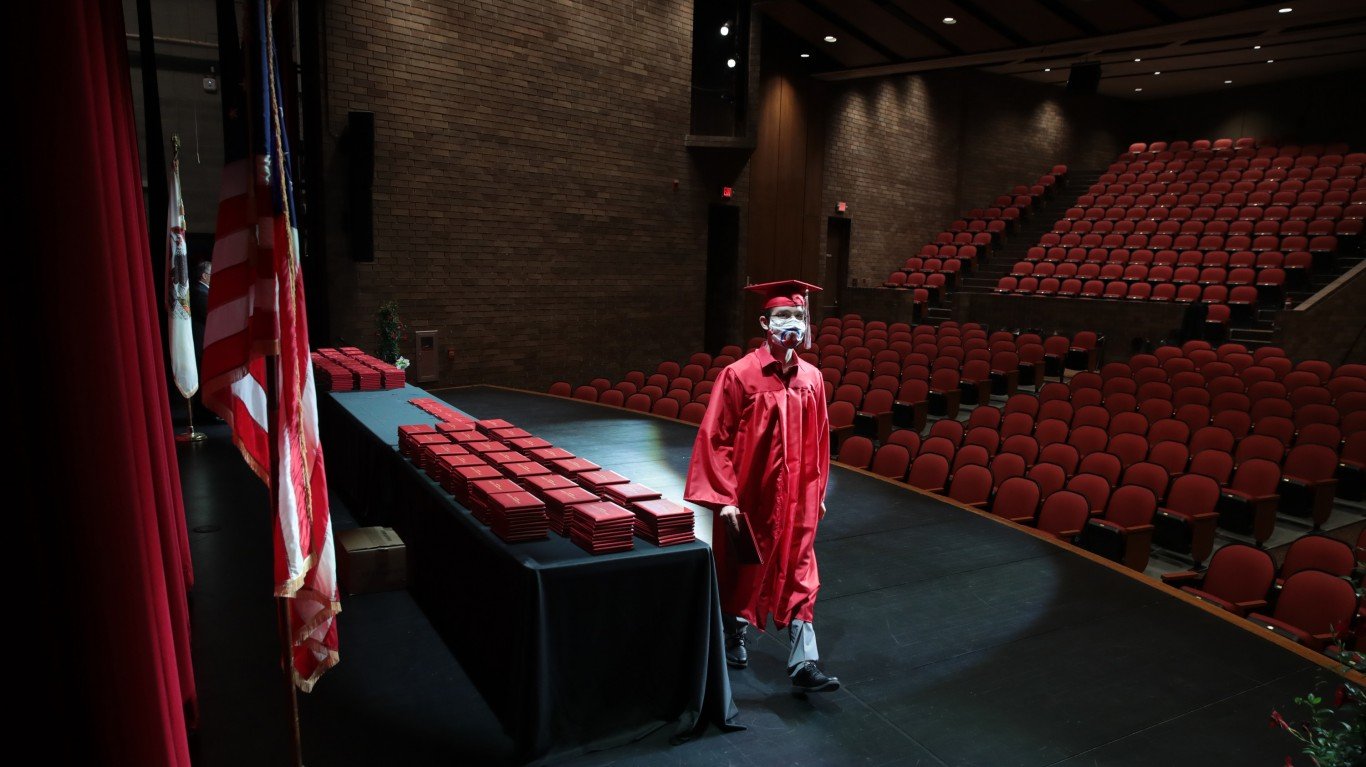
Illinois
> Cumulative COVID-19 cases as of July 9: 1,173 per 100,000 people — 10th highest (total: 149,432)
> COVID-19-related deaths as of July 9: 56 per 100,000 people — 8th highest (total: 7,099)
> Total tests administered as of July 9: 14,462 per 100,000 people — 9th highest (total: 1,842,576)
> Change in trailing 7-day avg. daily cases, June 1 – July 8: 3.8% — 7th smallest increase (from 144,013 to 149,432)
> Population: 12,741,080
The state began phase 4 of reopening on June 26. In phase 4, the limit on social gatherings expands from 10 to 50 people. Businesses in sectors such as health, fitness, movies, theaters, museums, and zoos can either open or expand capacity limits. Indoor dining can resume with groups of no more than 10 people, with tables spaced 6 feet apart in seated areas. Standing areas can’t exceed 25% of capacity. Indoor movie theaters can admit no more than 50 guests or 50% of full capacity.
People must wear masks or face coverings in public places where they cannot maintain 6 feet of distance from others. Public and private schools in the state can reopen for limited in-person summer school.
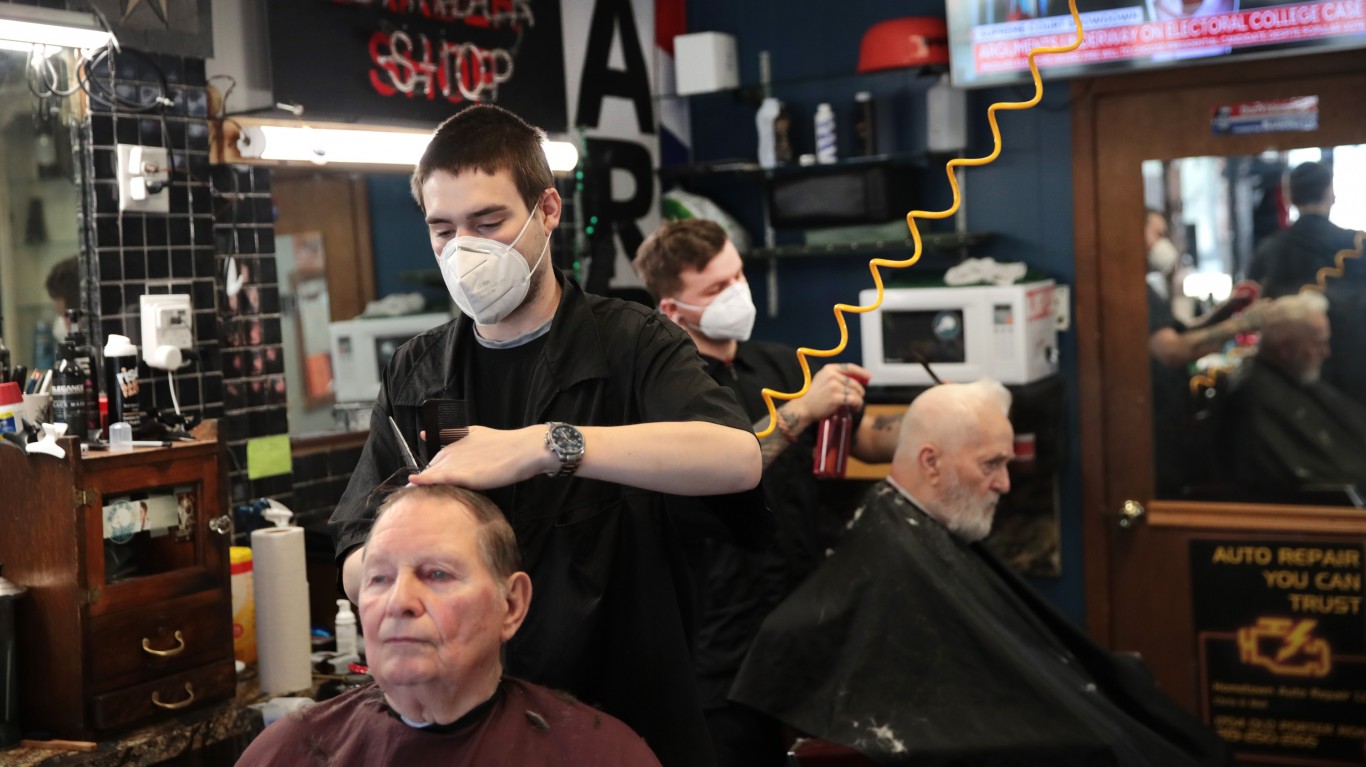
Indiana
> Cumulative COVID-19 cases as of July 9: 733 per 100,000 people — 24th lowest (total: 49,063)
> COVID-19-related deaths as of July 9: 38 per 100,000 people — 13th highest (total: 2,539)
> Total tests administered as of July 9: 8,008 per 100,000 people — 15th lowest (total: 535,857)
> Change in trailing 7-day avg. daily cases, June 1 – July 8: 6.8% — 18th smallest increase (from 45,952 to 49,063)
> Population: 6,691,878
Phase 4 of reopening began on June 12. Restaurants can expand indoor dining to 75% capacity. Bars, nightclubs, bar seating in restaurants, movie theaters, bowling alleys, and similar entertainment facilities can open at 50% capacity with social distancing rules in place. Recreational sports can resume with restrictions. Amusement and water parks can open at 50% capacity with restrictions. The Department of Motor Vehicles resumed walk-in services, but driving skills exams are still not available.
Most restrictions will remain in place at least through July 17. Effective July 1, K-12 schools could begin operations for the 2020-2021 academic year. Fairs, festivals, and similar large outdoor events can now take place.
[in-text-ad-2]
Iowa
> Cumulative COVID-19 cases as of July 9: 1,026 per 100,000 people — 14th highest (total: 32,388)
> COVID-19-related deaths as of July 9: 23 per 100,000 people — 21st highest (total: 732)
> Total tests administered as of July 9: 10,938 per 100,000 people — 21st highest (total: 345,232)
> Change in trailing 7-day avg. daily cases, June 1 – July 8: 10.6% — 21st smallest increase (from 29,290 to 32,388)
> Population: 3,156,145
Iowa’s speedways, racetracks, and amphitheaters were allowed to reopen on June 1. Casinos were also allowed to reopen, as well as amusement parks, bowling alleys, pool halls, and arcades. Bars and other establishments that serve alcohol can reopen for indoor and outdoor seating. However, some restaurants and bars in major Iowa cities are voluntarily choosing to temporarily close doors again as the number of COVID-19 cases has been surging in big urban areas.
As of June 12, businesses, including gyms, could begin to operate at full capacity with social distancing and hygiene and public health measures. Swimming pools, indoor playgrounds, theaters and performance venues, senior citizen centers, and adult day care facilities can reopen in compliance with state guidance.
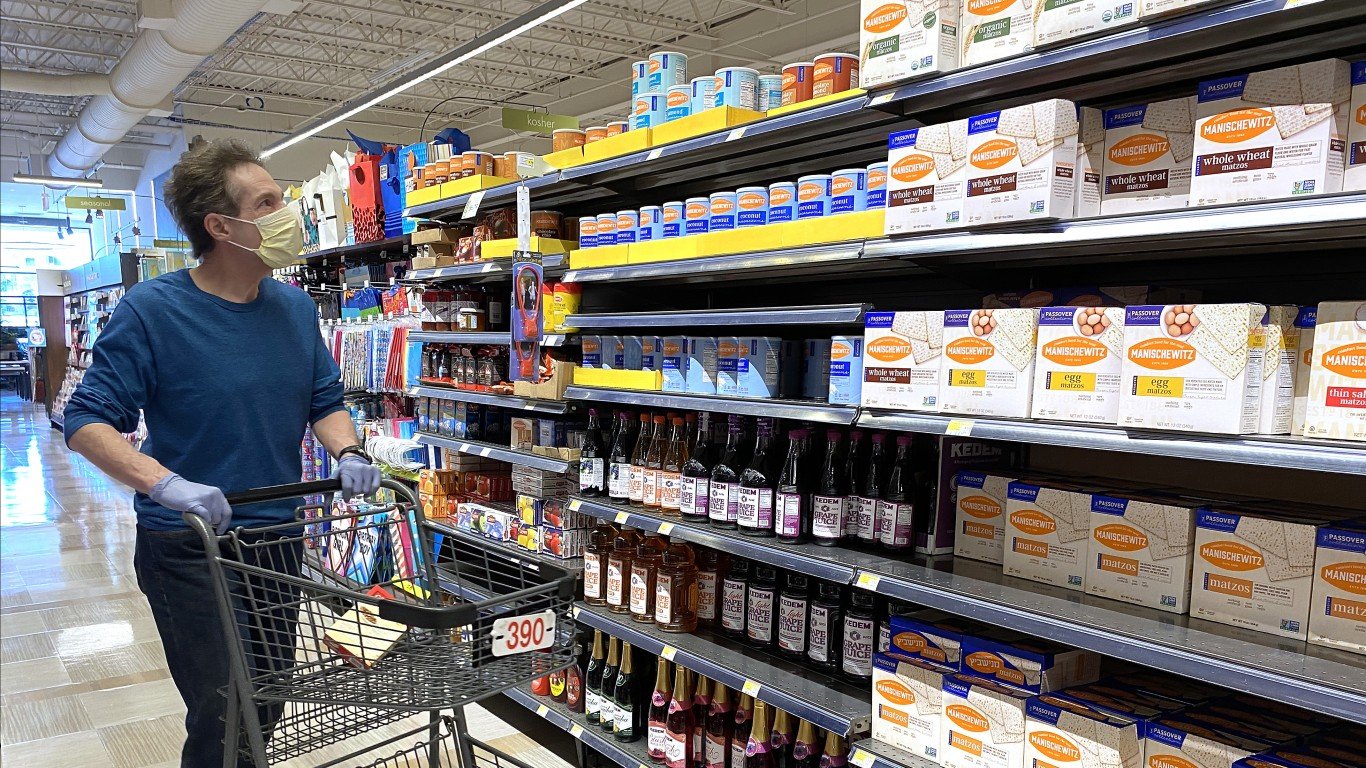
Kansas
> Cumulative COVID-19 cases as of July 9: 605 per 100,000 people — 18th lowest (total: 17,618)
> COVID-19-related deaths as of July 9: 10 per 100,000 people — 11th lowest (total: 282)
> Total tests administered as of July 9: N/A
> Change in trailing 7-day avg. daily cases, June 1 – July 8: 17.5% — 17th biggest increase (from 14,990 to 17,618)
> Population: 2,911,510
The third phase of the reopening began June 8. Due to spikes in coronavirus cases in some areas, local health officials recommend that phase 3 be delayed. Social gatherings of up to 45 people are now allowed, up from 15. Bars and restaurants must preserve a 6-foot distance between tables, booths, and barstools. Casinos and indoor leisure spaces can open as well. Nonessential travel may resume.
Restrictions on on-site staffing have been lifted. All education, activities, venues and establishments can operate if they follow public health guidelines. Local governments can impose stricter rules. Driving tests to get a driving license have resumed statewide since June 22. Everyone in the car has to wear a face mask.
[in-text-ad]
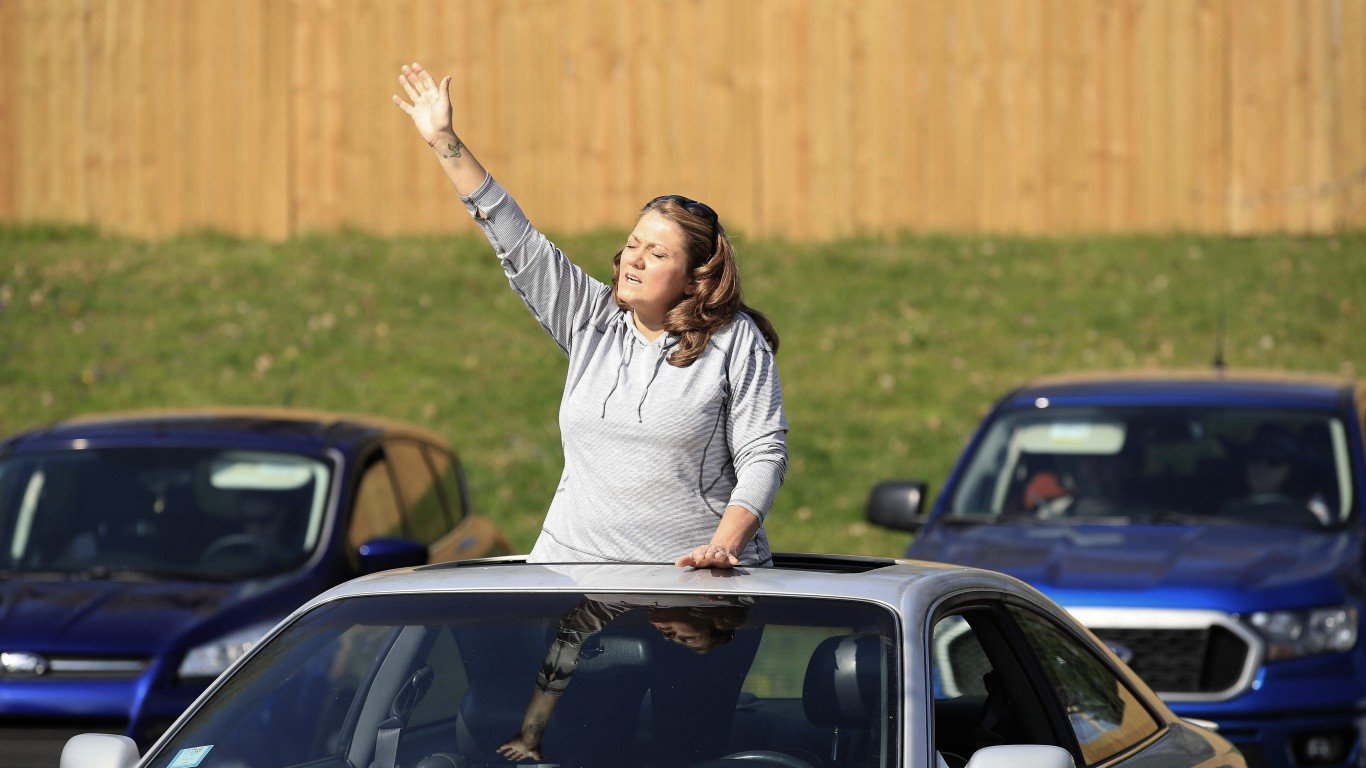
Kentucky
> Cumulative COVID-19 cases as of July 9: 401 per 100,000 people — 9th lowest (total: 17,919)
> COVID-19-related deaths as of July 9: 14 per 100,000 people — 18th lowest (total: 608)
> Total tests administered as of July 9: 9,292 per 100,000 people — 20th lowest (total: 415,204)
> Change in trailing 7-day avg. daily cases, June 1 – July 8: 13.1% — 22nd smallest increase (from 15,842 to 17,919)
> Population: 4,468,402
Movie theaters and fitness centers were allowed to reopen on June 1, and museums, outdoor attractions, aquariums, libraries, and distilleries were allowed to reopen on June 8. Campgrounds can now reopen. Child care services can reopen as well with reduced capacity. Restaurants and bars can expand capacity to 50% or more as long as people not from the same household can be 6 feet apart.
Outdoor seating is unlimited. Businesses that were permitted to operate at 33% capacity since May 22 have been allowed to increase capacity to 50% since June 22, provided they comply with guidelines. Effective June 29, gatherings of up to 50 people have been allowed, but people must maintain physical distancing. NASCAR races returned to the Kentucky Speedway on July 9 with no live audience.
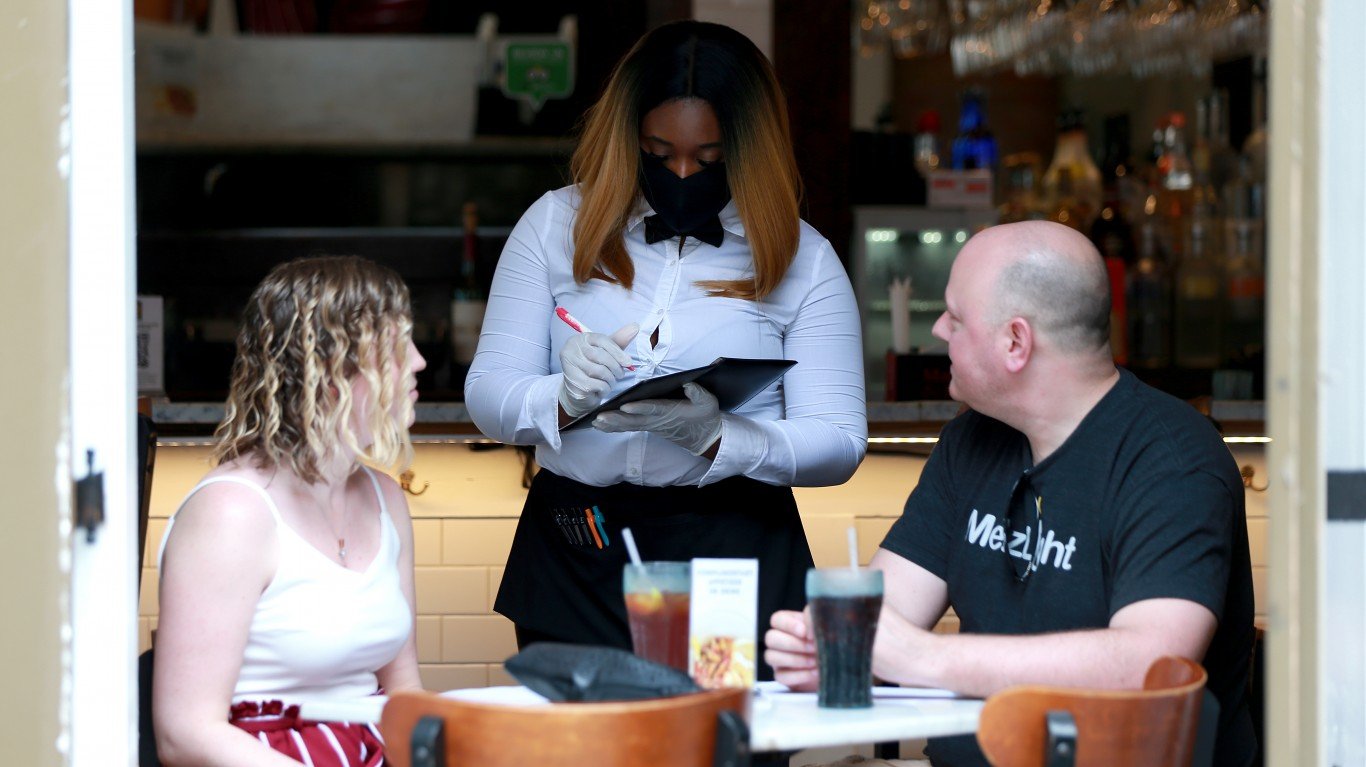
Louisiana
> Cumulative COVID-19 cases as of July 9: 1,505 per 100,000 people — 6th highest (total: 70,151)
> COVID-19-related deaths as of July 9: 69 per 100,000 people — 6th highest (total: 3,231)
> Total tests administered as of July 9: 18,578 per 100,000 people — 4th highest (total: 865,737)
> Change in trailing 7-day avg. daily cases, June 1 – July 8: 16.6% — 19th biggest increase (from 60,178 to 70,151)
> Population: 4,659,978
The state entered phase 2 of reopening on June 5 and was expected to last three weeks. However, Gov. John Bel Edwards announced on June 22 that Louisiana would remain in phase 2 for at least another four weeks as the numbers of new COVID-19 cases and hospitalizations have begun to rise. He issued an executive order capping indoor gatherings at no more than 250 people.
In phase 2, places of worship and businesses that were already allowed to open can expand to 50% capacity with social distancing. These businesses include massage and tattoo parlors, spas, bars and breweries with food permits, bowling alleys, arcades, pool halls, casinos and video poker, trampoline parks, event centers and wedding venues, and outdoor playgrounds and play centers. Employees who work with the public must wear face coverings. Businesses are strongly encouraged to offer temperature checks to patrons. Expanded phase 2 guidelines allow bars and nightclubs to host live music.

Maine
> Cumulative COVID-19 cases as of July 9: 260 per 100,000 people — 7th lowest (total: 3,486)
> COVID-19-related deaths as of July 9: 8 per 100,000 people — 9th lowest (total: 111)
> Total tests administered as of July 9: 8,607 per 100,000 people — 17th lowest (total: 115,196)
> Change in trailing 7-day avg. daily cases, June 1 – July 8: 5.0% — 11th smallest increase (from 3,294 to 3,460)
> Population: 1,338,404
As of June 17, all counties in Maine were allowed to reopen indoor dining with additional health and safety protocols. Bars, breweries, and tasting rooms can reopen for outdoor, seated service. Indoor service was supposed to resume July 1 but that has been postponed indefinitely due to coronavirus outbreaks in the state linked to indoor bars.
Gyms, tattoo parlors, and nail salons can open while adhering to requirements such as wearing masks and maintaining physical distance. Gatherings of people were increased to 50 from 10 as of June 1.
[in-text-ad-2]
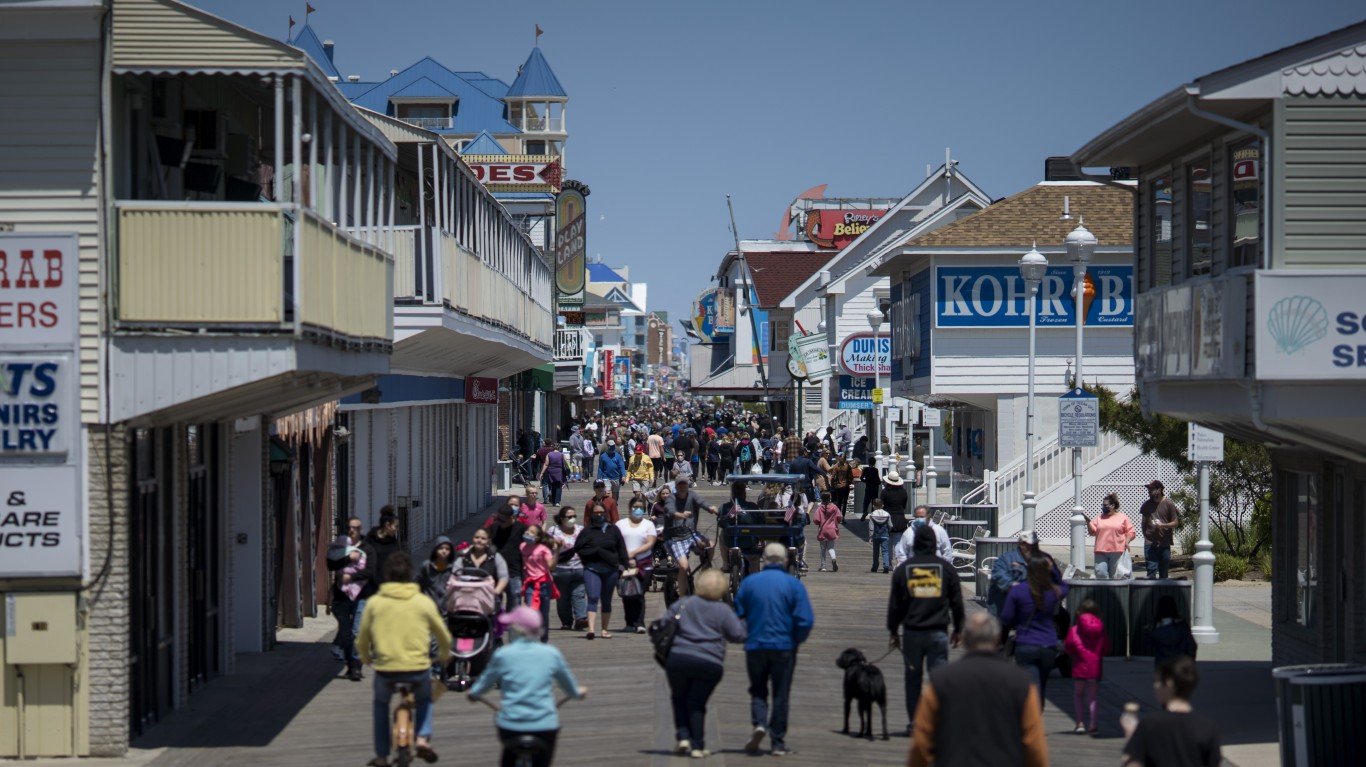
Maryland
> Cumulative COVID-19 cases as of July 9: 1,182 per 100,000 people — 9th highest (total: 71,447)
> COVID-19-related deaths as of July 9: 54 per 100,000 people — 9th highest (total: 3,288)
> Total tests administered as of July 9: N/A
> Change in trailing 7-day avg. daily cases, June 1 – July 8: 4.3% — 10th smallest increase (from 67,918 to 70,861)
> Population: 6,042,718
Maryland shifted to phase 2 of its reopening plan on June 5 by lifting the order requiring the closing of nonessential businesses. Restaurants can open indoor dining at 50% capacity. Outdoor amusements and rides can open with restrictions. As of June 19, indoor gyms, martial arts, dance, and other indoor fitness studio activities resumed activities at 50% capacity. All child care providers may start to reopen, with up to 15 people per room. Employees able to telework are encouraged to continue to do so. Other guidance from the state for the workplace includes wearing face coverings, conducting temperature checks for workers, implementing split schedules, and staggering shifts.
Outdoor high school sports can resume practices and training activities. Nursing homes are allowed to resume limited outdoor visitation as well as small group activities with proper precautions.
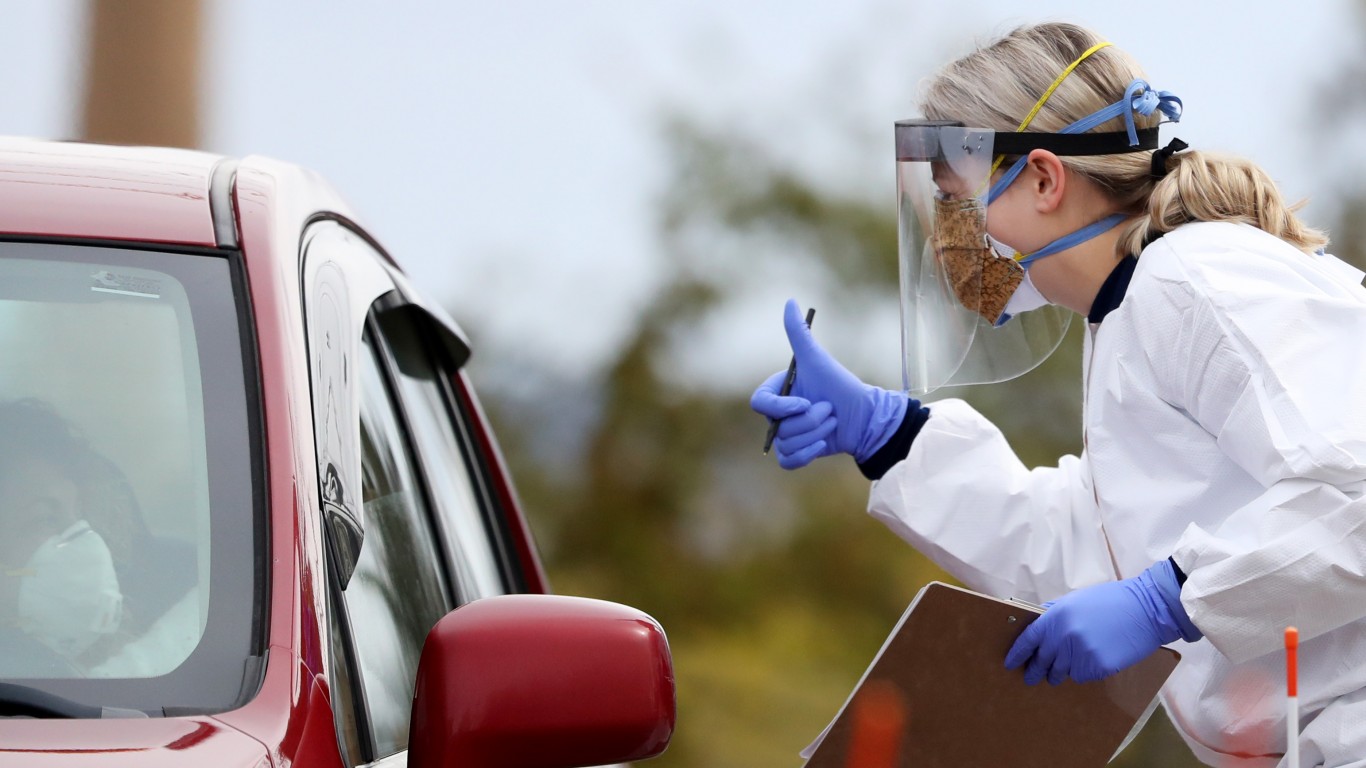
Massachusetts
> Cumulative COVID-19 cases as of July 9: 1,602 per 100,000 people — 4th highest (total: 110,602)
> COVID-19-related deaths as of July 9: 119 per 100,000 people — 4th highest (total: 8,243)
> Total tests administered as of July 9: 13,189 per 100,000 people — 12th highest (total: 910,354)
> Change in trailing 7-day avg. daily cases, June 1 – July 8: 1.3% — 4th smallest increase (from 109,143 to 110,602)
> Population: 6,902,149
Massachusetts, except for Boston, started phase 3 of reopening on July 6. Movie theaters, outdoor performance venues, museums, cultural and historical sites, fitness centers, health clubs, and some low-contact indoor recreational activities can now resume but with capacity restrictions. Professional sports teams can hold games without a live audience. Indoor gatherings are limited to eight people per 1,000 square feet but cannot exceed 25 people in a single enclosed space. Outdoor gatherings in enclosed spaces are limited to 25% occupancy with no more than 100 people in a single enclosed outdoor space.
[in-text-ad]
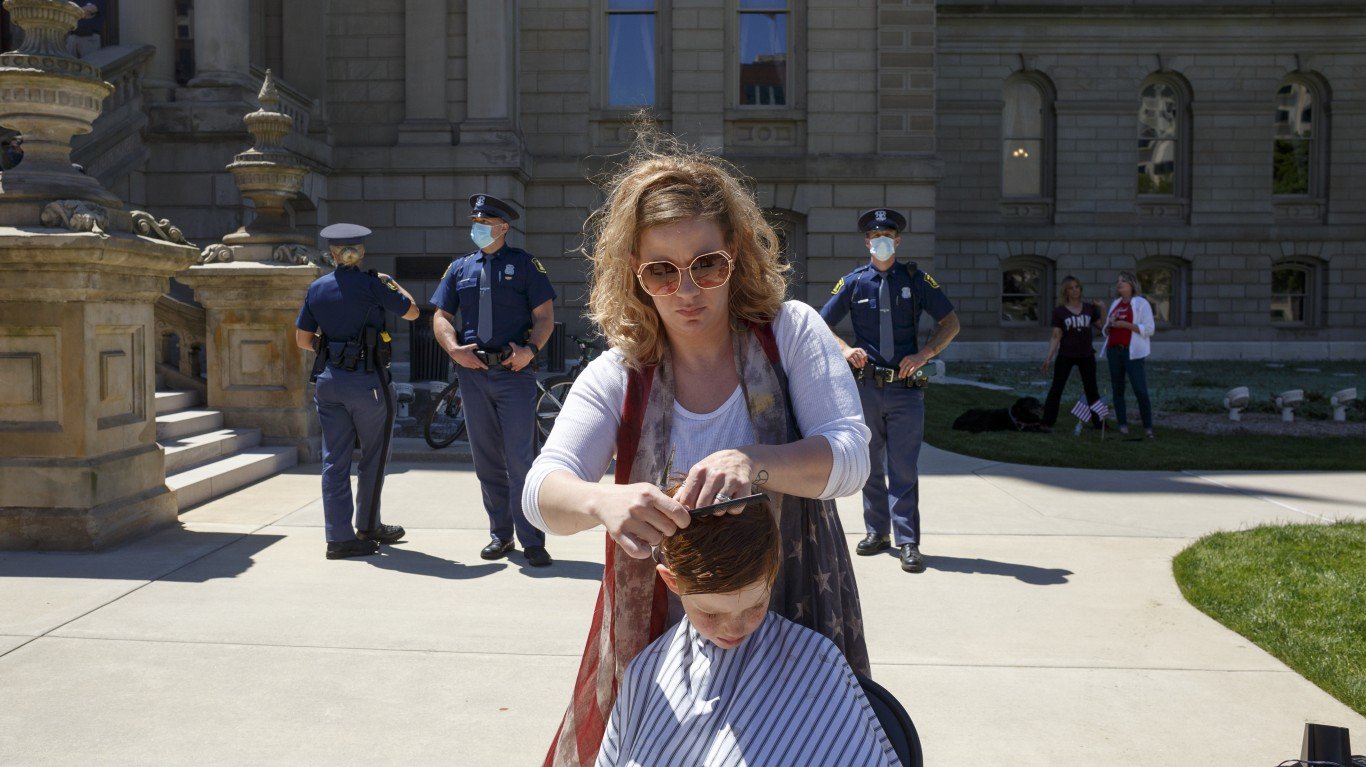
Michigan
> Cumulative COVID-19 cases as of July 9: 746 per 100,000 people — 25th highest (total: 74,551)
> COVID-19-related deaths as of July 9: 63 per 100,000 people — 7th highest (total: 6,262)
> Total tests administered as of July 9: 12,186 per 100,000 people — 17th highest (total: 1,218,053)
> Change in trailing 7-day avg. daily cases, June 1 – July 8: 4.0% — 9th smallest increase (from 71,089 to 73,900)
> Population: 9,995,915
Retailers are open in Michigan, but with capacity limits. Swimming pools, libraries, museums, and day camps for children can open as well. Groups of up to 250 people are allowed to gather outdoors. Indoor gatherings are limited to 10 people. Outdoor performance and sporting venues can reopen but with a capacity of no more than 500 people. Hair salons and similar personal care businesses can resume services with some restrictions.
Phase 5 of reopening in some regions was postponed due to isolated outbreaks of new COVID-19 cases in some parts of the state. On July 1, Gov. Gretchen Whitmer signed an executive order closing indoor service at bars in most of the lower part of the state because the recent outbreaks were linked to bars. People statewide are required to wear non-medical grade face coverings in closed public spaces. Employers are obliged to provide masks to employees who are back in the office.
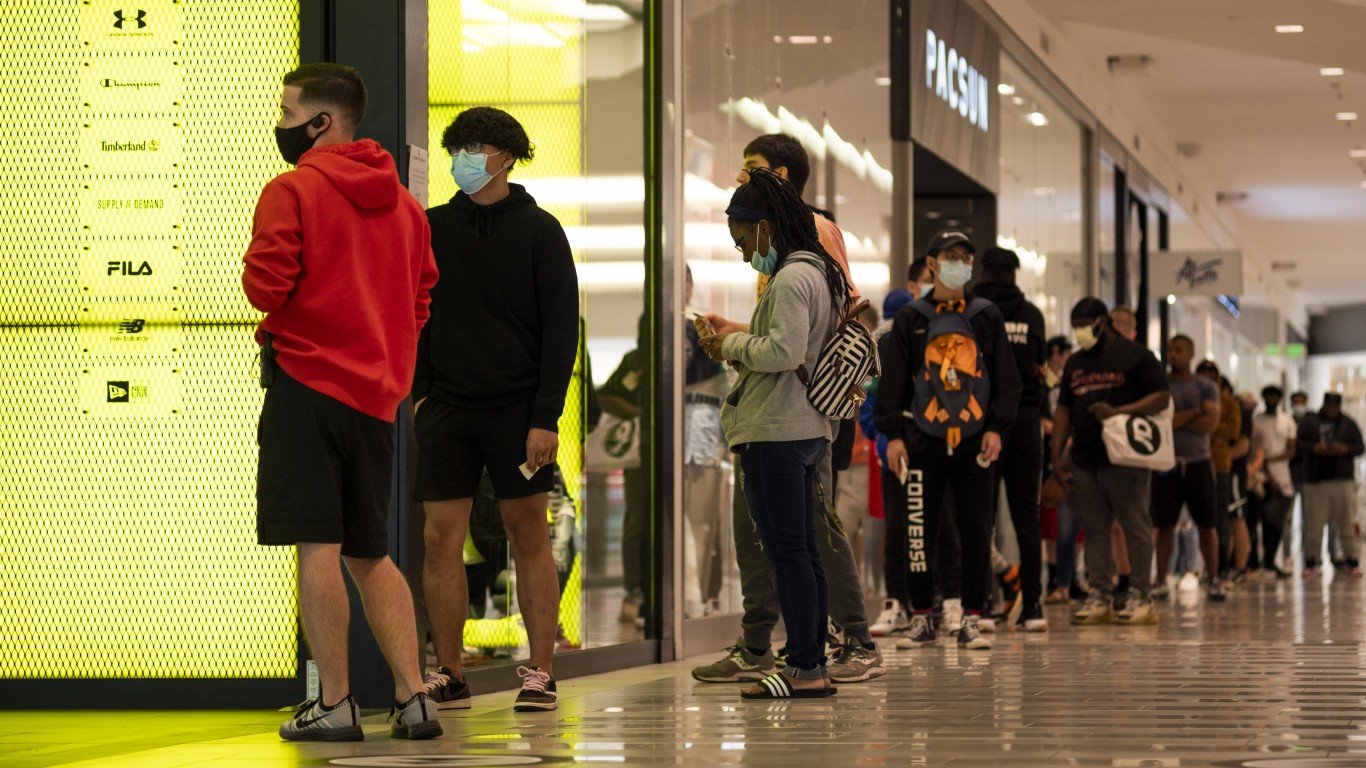
Minnesota
> Cumulative COVID-19 cases as of July 9: 706 per 100,000 people — 21st lowest (total: 39,589)
> COVID-19-related deaths as of July 9: 26 per 100,000 people — 18th highest (total: 1,485)
> Total tests administered as of July 9: 12,350 per 100,000 people — 15th highest (total: 692,970)
> Change in trailing 7-day avg. daily cases, June 1 – July 8: 7.8% — 19th smallest increase (from 36,716 to 39,589)
> Population: 5,611,179
Minnesota is in phase 3 of reopening. The plan allows for the limited reopening of indoor dining, gyms, and entertainment venues. Restaurants can open indoor dining at 50% capacity, but reservations are required. Gyms, movie theaters, and other indoor entertainment venues can open at 25% capacity. Hair salons, barbershops, and tattoo parlors can expand to 50% capacity, but clients have to make reservations. Places of worship can expand to 50% capacity.
Outdoor event venues, including sporting events, concerts, and theaters, can open at 25% capacity. Indoor social gatherings are limited to 10 people. Outdoors, people can gather in groups of 25. Public swimming pools can reopen at 50% capacity if they have a COVID-19 Preparedness Plan. Youth sports can begin team practices and outdoor games and scrimmages. Indoor games and scrimmages resumed on July 1.
Mississippi
> Cumulative COVID-19 cases as of July 9: 1,101 per 100,000 people — 11th highest (total: 32,888)
> COVID-19-related deaths as of July 9: 40 per 100,000 people — 12th highest (total: 1,188)
> Total tests administered as of July 9: 10,529 per 100,000 people — 24th highest (total: 314,459)
> Change in trailing 7-day avg. daily cases, June 1 – July 8: 17.9% — 16th biggest increase (from 27,900 to 32,888)
> Population: 2,986,530
Mississippi’s safer-at-home order ended June 1 and has been replaced by a safe return order, which was effective until June 15. Social gatherings must comply with social distancing requirements, with a limit of 50 people indoors and no more than 100 people outdoors. Gatherings where people cannot socially distance have limits of 20 people indoors and up to 50 people outside.
Restaurants and bars can now have live music performances, with customers and musicians maintaining at least a 12-foot distance. Gyms and fitness centers can expand to 50% capacity. Outdoor and indoor arenas can open but limit seating to 25% capacity.
Gov. Tate Reeves’ Safe Return executive order was extended until July 20 following a recent spike in new COVID-19 cases. The order was amended to allow concession stands at outdoor sports complexes and multi-field complexes to open with restrictions. It also allows public pools to be open to the public 24 hours a day.
[in-text-ad-2]
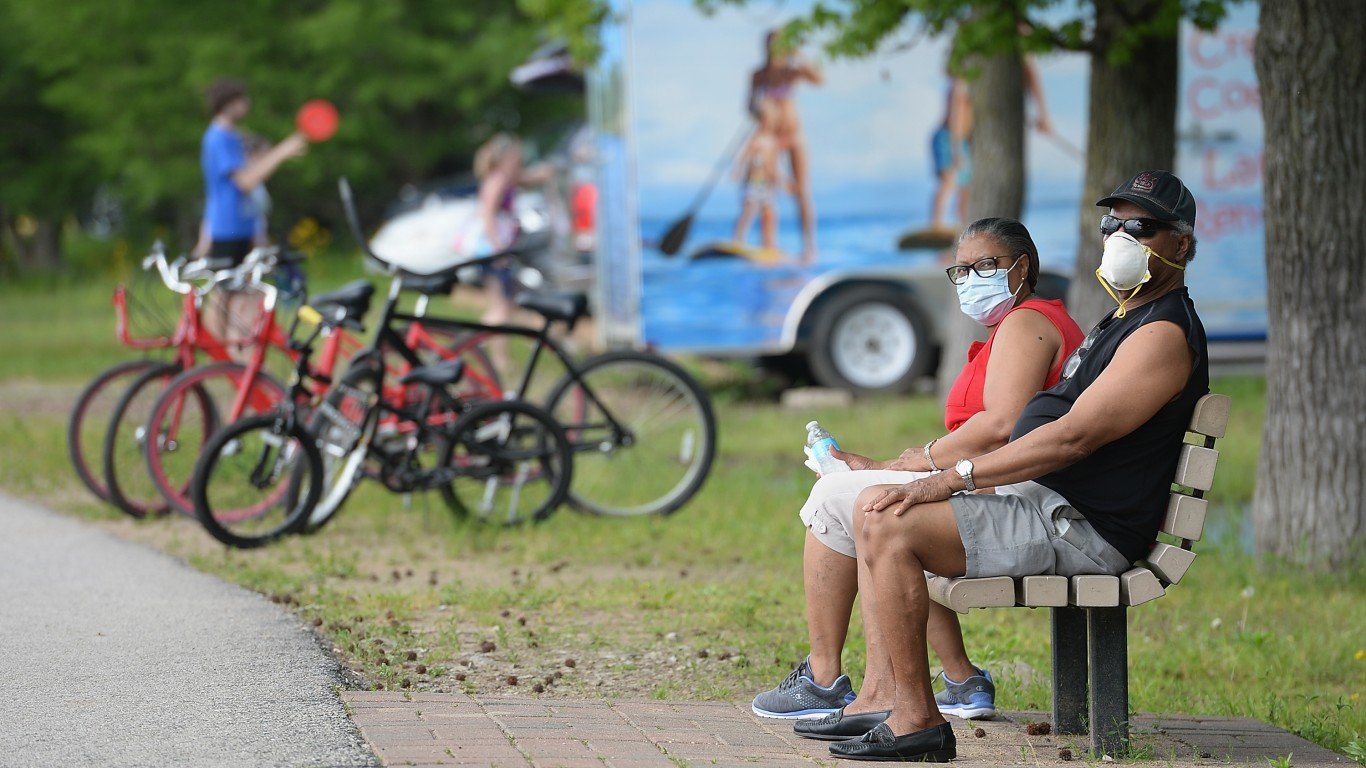
Missouri
> Cumulative COVID-19 cases as of July 9: 411 per 100,000 people — 10th lowest (total: 25,204)
> COVID-19-related deaths as of July 9: 17 per 100,000 people — 23rd lowest (total: 1,046)
> Total tests administered as of July 9: 7,220 per 100,000 people — 12th lowest (total: 442,340)
> Change in trailing 7-day avg. daily cases, June 1 – July 8: 14.9% — 23rd biggest increase (from 21,927 to 25,204)
> Population: 6,126,452
Phase 2, which began June 15, allows the maximum number of people gathering in one place to increase to 50 people from 10. Also in phase 2, businesses such as restaurants, places of worship, gyms, and salons may boost operations to 50% capacity as long as social distancing is followed.
Local officials still have the authority to put further restrictions in place. Outside and window visitations at long-term care facilities are now allowed provided they comply with social distancing protocols. Group dining and group activities in the facilities may resume under certain circumstances, including not having any cases of COVID-19 among staff or residents, or it has been 28 days since the last coronavirus case was confirmed.

Montana
> Cumulative COVID-19 cases as of July 9: 129 per 100,000 people — 2nd lowest (total: 1,371)
> COVID-19-related deaths as of July 9: 2 per 100,000 people — 2nd lowest (total: 23)
> Total tests administered as of July 9: 10,018 per 100,000 people — 25th lowest (total: 106,421)
> Change in trailing 7-day avg. daily cases, June 1 – July 8: 34.9% — 3rd biggest increase (from 1,016 to 1,371)
> Population: 1,062,305
Phase 2 of reopening started on June 1, and gatherings are now limited to a maximum of 50 people. Also beginning on June 1, restaurants, bars, breweries distilleries, and casinos were allowed to expand to 75% capacity. Gyms, indoor group fitness classes, pools, and hot tubs can also operate at 75% capacity. Concert halls, bowling alleys, and other places of assembly can resume activities but with reduced capacity.
The 24-person cap per child care facility has been lifted. Employers should still allow employees to work remotely as much as possible. Glacier National Park began to reopen certain parts of the park on June 8. Areas of the west side of the park are open for day-use only. Montana’s gates to Yellowstone National Park in West Yellowstone, as well as Gardiner and Cooke City, are now open as well.
[in-text-ad]
Nebraska
> Cumulative COVID-19 cases as of July 9: 1,059 per 100,000 people — 13th highest (total: 20,425)
> COVID-19-related deaths as of July 9: 15 per 100,000 people — 21st lowest (total: 282)
> Total tests administered as of July 9: 10,267 per 100,000 people — 25th highest (total: 198,069)
> Change in trailing 7-day avg. daily cases, June 1 – July 8: 5.8% — 13th smallest increase (from 19,310 to 20,425)
> Population: 1,929,268
Nebraska is in phase 3 of reopening. In phase 3, restaurants and bars can expand to 100% occupancy with no more than eight people per table. Games such as pool and darts will be allowed. Self-serve buffets and salad bars are still banned. Gyms, fitness centers, and health clubs can operate at 75% capacity. Personal care service businesses can operate at 75% capacity, but everyone has to wear a mask. Indoor gatherings can expand to 50% of rated occupancy, and outdoor gatherings can expand to 75%, but no gatherings can exceed 10,000 people.
Statewide, as of June 22, fan attendance for youth and school games expanded and is no longer limited to household members only. Contact team sports began practices and games after July 1. Drive-in movies can resume, but people must remain inside their cars. A modified Nebraska State Fair will take place Aug. 28-Sept. 7.
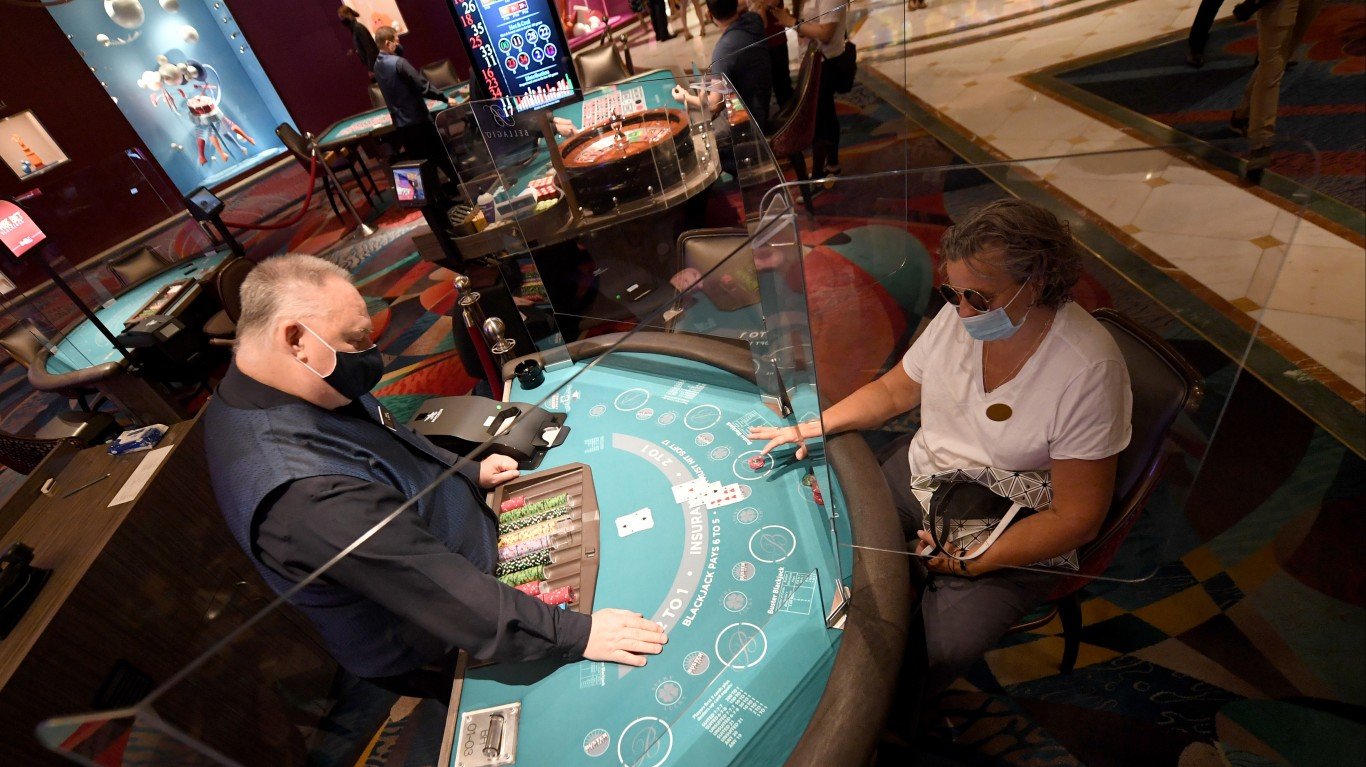
Nevada
> Cumulative COVID-19 cases as of July 9: 801 per 100,000 people — 22nd highest (total: 24,301)
> COVID-19-related deaths as of July 9: 18 per 100,000 people — 25th lowest (total: 553)
> Total tests administered as of July 9: 13,071 per 100,000 people — 13th highest (total: 396,632)
> Change in trailing 7-day avg. daily cases, June 1 – July 8: 27.2% — 7th biggest increase (from 19,101 to 24,301)
> Population: 3,034,392
The state began phase 2 of reopening on May 29 and will remain in phase 2 at least until the end of July due to a surge of new coronavirus cases in the state. Phase 2 allows salons and tattoo parlors to open. Pools, museums, zoos, malls, bowling alleys, movie theaters, and more are also allowed to reopen with reduced capacity. Nevada’s gaming industry reopened on June 4. Live events such as sports, concerts, and theater performances may be held for broadcast, with no in-person spectators allowed. Schools will reopen for summer classes and activities.
Local officials have the authority to tighten restrictions in their area if necessary. As of June 26, people have been required to wear masks anywhere in public.

New Hampshire
> Cumulative COVID-19 cases as of July 9: 439 per 100,000 people — 11th lowest (total: 5,952)
> COVID-19-related deaths as of July 9: 28 per 100,000 people — 15th highest (total: 386)
> Total tests administered as of July 9: 9,556 per 100,000 people — 22nd lowest (total: 129,628)
> Change in trailing 7-day avg. daily cases, June 1 – July 8: 2.6% — 6th smallest increase (from 5,802 to 5,952)
> Population: 1,356,458
Services like salons, massage therapy centers, and tattoo shops have reopened. Beach activities are now allowed at state seacoast beaches. As of June 15, gyms can open at 50% capacity, and amateur sports can move into phase 2. Indoor athletic facilities and road races can reopen. Bowling alleys, libraries, funeral homes, museums, art galleries, and pools can also open. Outdoor attractions such as tourist trains can resume. Overnight summer camps can open a week after that. Indoor movie theaters, performing arts centers, and amusement parks can all open with capacity limits.
As of June 29, larger hotels, inns, and campgrounds could operate at 100% capacity. The New Hampshire Motor Speedway will host the rescheduled NASCAR Cup Series Foxwoods Resort Casino 301 on Aug. 2, with the grandstands at up to 50% capacity. There is no longer a quarantine requirement for people coming from Maine, Vermont, Massachusetts, Connecticut, or Rhode Island for recreational activities.
[in-text-ad-2]
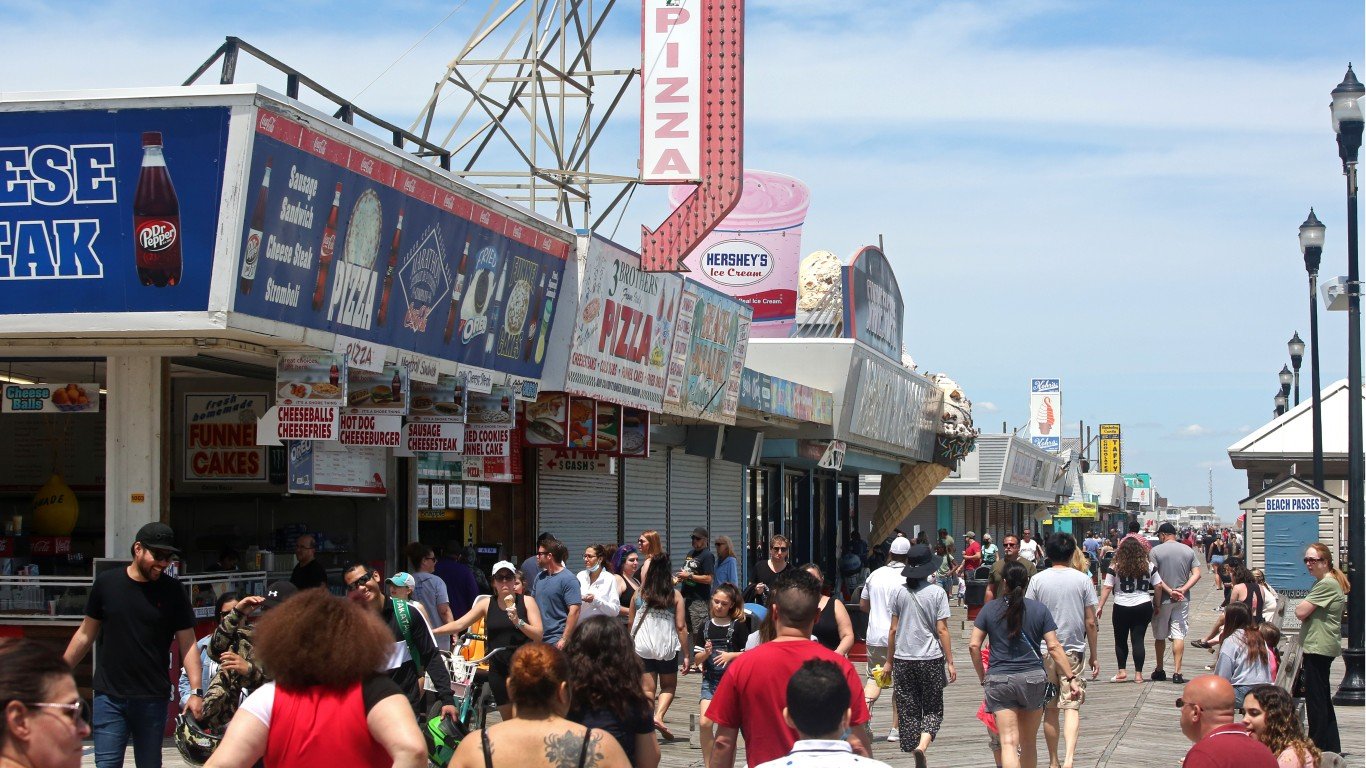
New Jersey
> Cumulative COVID-19 cases as of July 9: 1,954 per 100,000 people — 2nd highest (total: 174,039)
> COVID-19-related deaths as of July 9: 173 per 100,000 people — the highest (total: 15,423)
> Total tests administered as of July 9: 17,712 per 100,000 people — 6th highest (total: 1,577,848)
> Change in trailing 7-day avg. daily cases, June 1 – July 8: 1.2% — 2nd smallest increase (from 171,928 to 174,039)
> Population: 8,908,520
New Jersey’s stay-at-home order was lifted on June 9. Phase 2 of reopening started on June 15. Museums, libraries, limited in-person government services, and gyms can reopen. Outdoor dining and limited in-person retail can resume. Hair salons and barbershops were allowed to reopen after June 22. Nonessential retail stores opened after June 15 at 50% capacity. Indoor portions of malls reopened with restrictions on June 29.
Outdoor organized sports that involve no or little contact resumed on June 22. Traditional practices and competitions were allowed to resume after July 6 for medium-risk sports and after July 20 for high-risk sports. Amusement parks, casinos, and playgrounds statewide are allowed to reopen. The limit on outdoor gatherings was raised to 500 people on July 3. Graduations have a 500-person limit. People can gather outside in groups of 100.
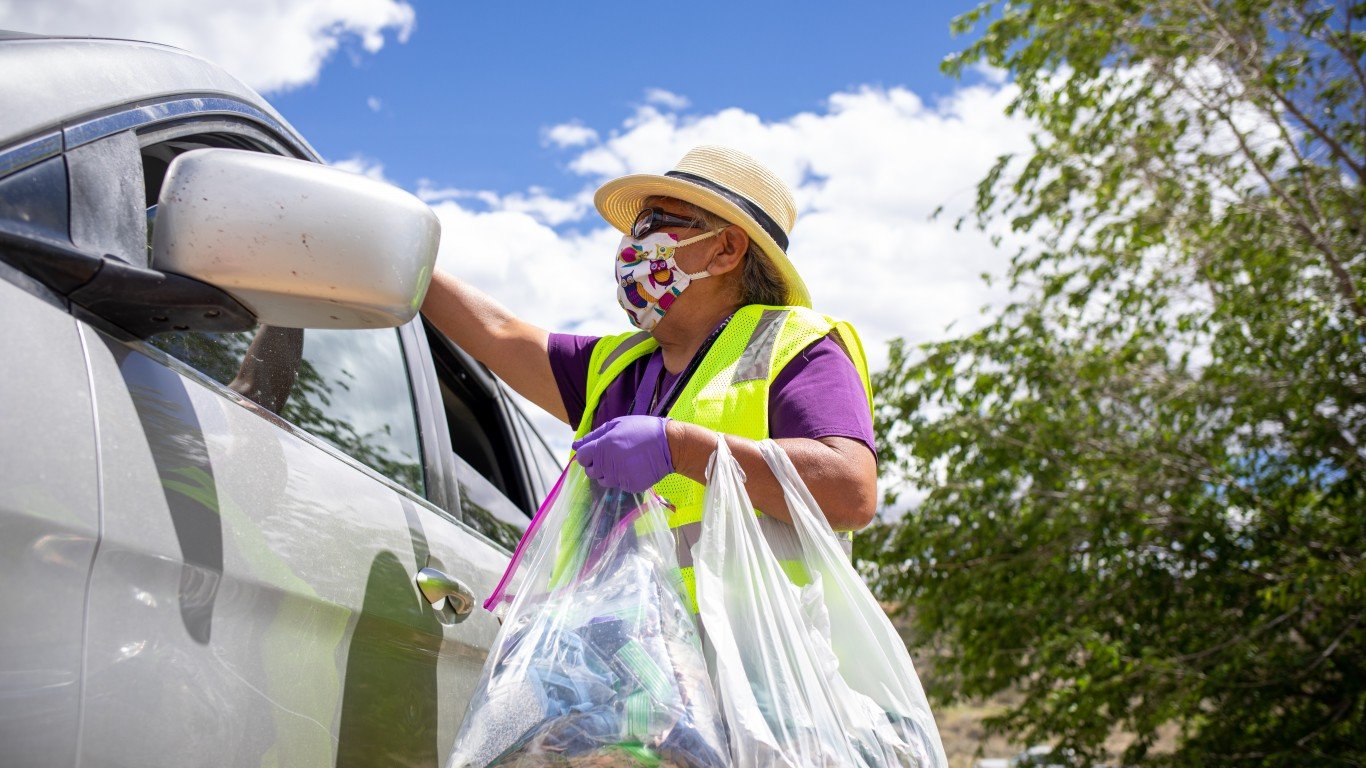
New Mexico
> Cumulative COVID-19 cases as of July 9: 669 per 100,000 people — 20th lowest (total: 14,017)
> COVID-19-related deaths as of July 9: 25 per 100,000 people — 20th highest (total: 527)
> Total tests administered as of July 9: 18,597 per 100,000 people — 3rd highest (total: 389,687)
> Change in trailing 7-day avg. daily cases, June 1 – July 8: 14.2% — 25th biggest increase (from 12,276 to 14,017)
> Population: 2,095,428
Nonessential businesses and services, including retailers, are allowed to reopen at 25% capacity. Gatherings of more than five people are not allowed. Restaurants are now allowed to resume indoor seating at 50% capacity. Tables must be at least 6 feet apart, and each table can have no more than six customers. Gyms can also reopen and operate at 50% capacity. Malls, barbershops, and tattoo parlors can open at 25% capacity. Many state parks are now open for day use. Breweries can now offer outdoor and patio seating at 50% capacity, in line with social distancing protocols. Indoor service is allowed at 50% capacity, but bar and counter seating is still banned.
COVID-19 testing sites located throughout the state now offer free testing on Mondays for employees at restaurants, farmers’ markets, food manufacturing facilities, and grocery stores. Gov. Michelle Lujan Grisham said on July 1 she might have to re-enact restrictions due to rising transmission rates in every part of the state.
[in-text-ad]
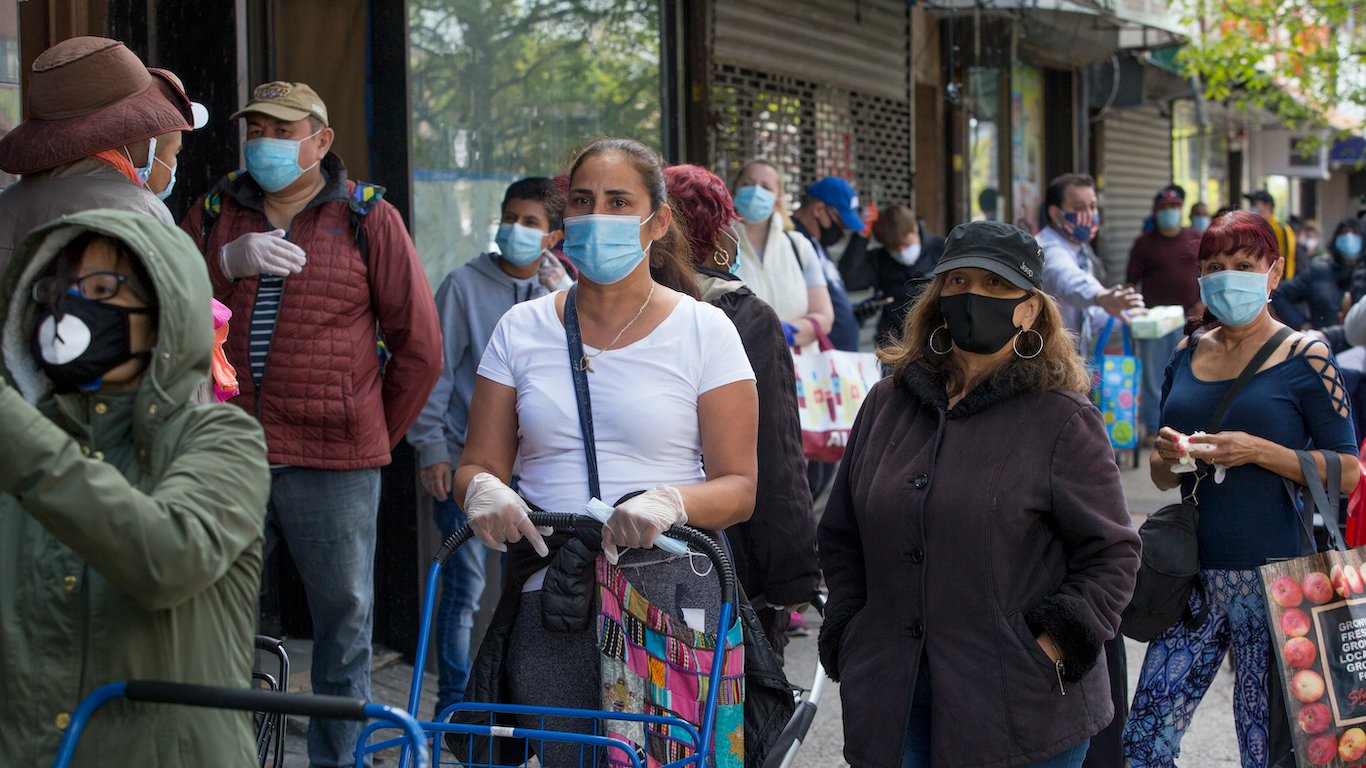
New York
> Cumulative COVID-19 cases as of July 9: 2,041 per 100,000 people — the highest (total: 398,929)
> COVID-19-related deaths as of July 9: 128 per 100,000 people — 2nd highest (total: 24,944)
> Total tests administered as of July 9: 22,528 per 100,000 people — 2nd highest (total: 4,402,452)
> Change in trailing 7-day avg. daily cases, June 1 – July 8: 1.2% — 3rd smallest increase (from 394,079 to 398,929)
> Population: 19,542,209
Businesses can deny entry to people without masks. In-person special education instruction can take place over the summer. Five regions entered phase 4 on June 26 — Central New York, Finger Lakes, Mohawk Valley, North Country, and Southern Tier. In phase 4, gatherings of up to 50 people are allowed, an increase from 25 allowed in phase 3. Long Island entered phase 3 on June 24. State park outdoor pools across New York are now allowed to reopen for swimming, but only at up to 50% capacity.
New York City entered phase 3 on July 6. Personal care services can open but limit workforce and customer presence to 50% of maximum occupancy. In the food service industry, indoor dining is limited to 50% capacity, and tables must be 6 feet apart or have a barrier that is at least 5 feet high. Outdoors, the table must be located at least 6 feet apart.
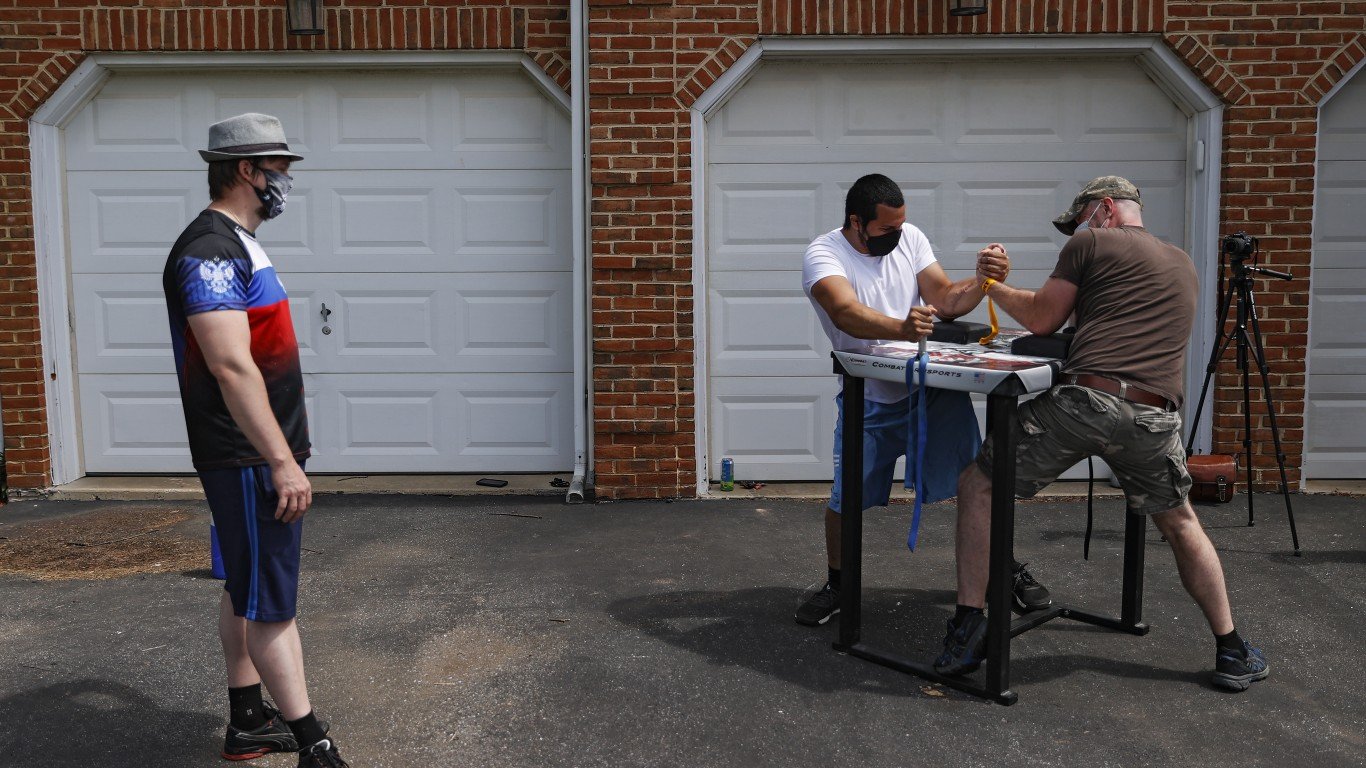
North Carolina
> Cumulative COVID-19 cases as of July 9: 745 per 100,000 people — 25th lowest (total: 77,310)
> COVID-19-related deaths as of July 9: 14 per 100,000 people — 19th lowest (total: 1,441)
> Total tests administered as of July 9: 10,562 per 100,000 people — 23rd highest (total: 1,096,682)
> Change in trailing 7-day avg. daily cases, June 1 – July 8: 16.2% — 20th biggest increase (from 66,513 to 77,310)
> Population: 10,383,620
North Carolina entered its first phase of reopening on May 8, allowing retailers to operate at 50% capacity and child care centers to reopen. The modified stay-at-home order expired on May 22, when the state entered phase 2. Under the new rules, gatherings of up to 10 people indoors and 25 people outdoors are allowed. The state also advises residents to maintain at least 6 feet of distance from others in public and wear a face mask. Restaurants are now open but must operate at 50% capacity and follow strict sanitation and social distancing guidelines.
Phase 2 was set to expire on June 26, but the state paused further reopening plans due to a surge in new COVID-19 cases. People in North Carolina are now required to wear face coverings when in public, making the state the first in the South to issue such a mandate. Children under 11, people with preexisting conditions, and those exercising outdoors are exempt.
North Dakota
> Cumulative COVID-19 cases as of July 9: 522 per 100,000 people — 16th lowest (total: 3,971)
> COVID-19-related deaths as of July 9: 11 per 100,000 people — 17th lowest (total: 85)
> Total tests administered as of July 9: 15,240 per 100,000 people — 7th highest (total: 115,839)
> Change in trailing 7-day avg. daily cases, June 1 – July 8: 9.8% — 20th smallest increase (from 3,615 to 3,971)
> Population: 760,077
North Dakota is one of a handful of states that never issued a statewide stay-at-home order. The order for all nonessential businesses to close ended on April 30. Some businesses, including movie theaters, gyms, salons, tattoo parlors, bars, and restaurants have been allowed to open. Bars and restaurants are now allowed to increase capacity to 75%; movie theaters are allowed to increase capacity to 65%; and fitness centers may consider resuming classes with social distancing. The recommended capacity for banquets and weddings increased to 75% of venue occupancy, but to no more than 500 people.
Long-term care facilities can start a phased approach to resuming visitation, preferably outdoors. Visitors should make an appointment. Nursing homes approved for phase 1 can resume group dining and other activities such as bingo.
[in-text-ad-2]
Ohio
> Cumulative COVID-19 cases as of July 9: 515 per 100,000 people — 15th lowest (total: 60,181)
> COVID-19-related deaths as of July 9: 26 per 100,000 people — 19th highest (total: 2,991)
> Total tests administered as of July 9: N/A
> Change in trailing 7-day avg. daily cases, June 1 – July 8: 13.8% — 24th smallest increase (from 52,865 to 60,181)
> Population: 11,689,442
The modified stay-at-home order expired on May 29. People are required to wear face coverings when in public. Gyms and fitness centers are able to reopen and non-contact and limited-contact sports can resume with safety protocols in place. Public and club pools can reopen as can miniature golf, batting cages, and bowling alleys. Catering and banquet centers can reopen if tables are at least 6 feet apart and gatherings don’t exceed 300 people. Entertainment facilities such as country clubs, indoor movie theaters, outdoor playgrounds, trampoline parks, and zoos can now also open. Casinos, amusement parks, and water parks can open beginning June 19.
Contact practice for all sports were allowed to resume on June 22, as long as participants adhere to safety protocols.
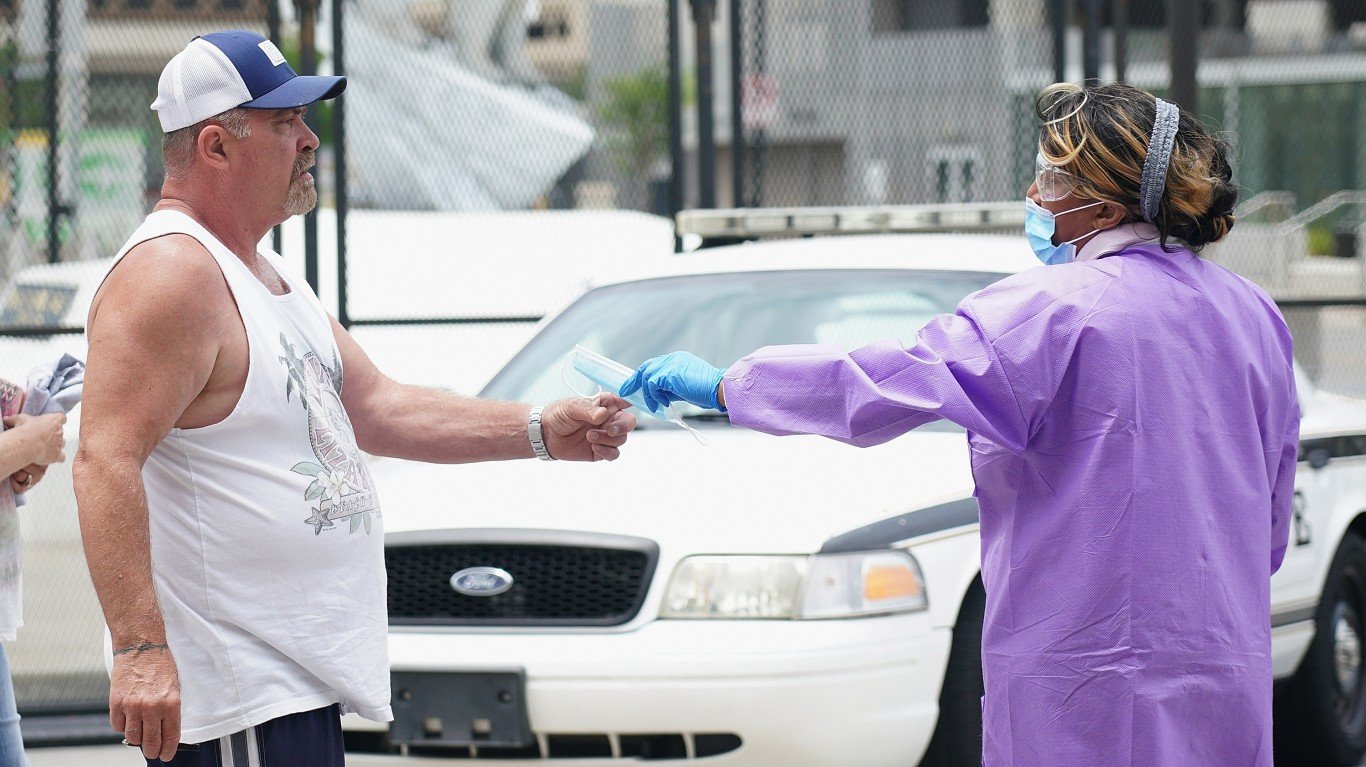
Oklahoma
> Cumulative COVID-19 cases as of July 9: 454 per 100,000 people — 12th lowest (total: 17,893)
> COVID-19-related deaths as of July 9: 10 per 100,000 people — 15th lowest (total: 407)
> Total tests administered as of July 9: N/A
> Change in trailing 7-day avg. daily cases, June 1 – July 8: 26.8% — 8th biggest increase (from 14,112 to 17,893)
> Population: 3,943,079
The state never issued a statewide stay-at-home order except for older people and those who have certain preexisting conditions. Restrictions on salons, barbers, and pet groomers have been lifted. Restaurant dining, movie theaters, gyms, houses of worship, and sporting venues have been allowed to reopen since May 1 with certain restrictions, including adhering to strict social distancing and sanitation protocols.
Phase 3 of reopening started on June 1. Businesses can now resume staffing at their work sites, but social distancing guidelines must be followed. Businesses that were operating by appointment only can now start accepting walk-ins. Summer camps can open in line with safety guidelines. Limited visitation to hospitals may resume. Visitation at nursing homes and long-term care facilities can now resume in a phased approach.
[in-text-ad]
Oregon
> Cumulative COVID-19 cases as of July 9: 258 per 100,000 people — 6th lowest (total: 10,817)
> COVID-19-related deaths as of July 9: 5 per 100,000 people — 6th lowest (total: 224)
> Total tests administered as of July 9: 6,579 per 100,000 people — 10th lowest (total: 275,727)
> Change in trailing 7-day avg. daily cases, June 1 – July 8: 21.1% — 14th biggest increase (from 8,931 to 10,817)
> Population: 4,190,713
A stay-at-home order is in effect until further notice. Counties can begin lifting some restrictions when they meet certain requirements and must stay in phase 1 of the reopening for at least three weeks. However, due to a surge of new COVID-19 cases in the state, all phase 1 counties will only be eligible to progress to phase 2 at least 21 days after June 19. As of July 1, a statewide order mandated that people wear face coverings in indoor public spaces.
Most counties in the state are in phase 2. In phase 2, gatherings are limited to 50 people indoors and 100 people outdoors, and restaurants and bars can extend their curfews to midnight. Movie theaters and large venues can expand their occupancy to up to 250 people. For now, the state has paused all further reopening efforts due to a surge in new COVID-19 cases.
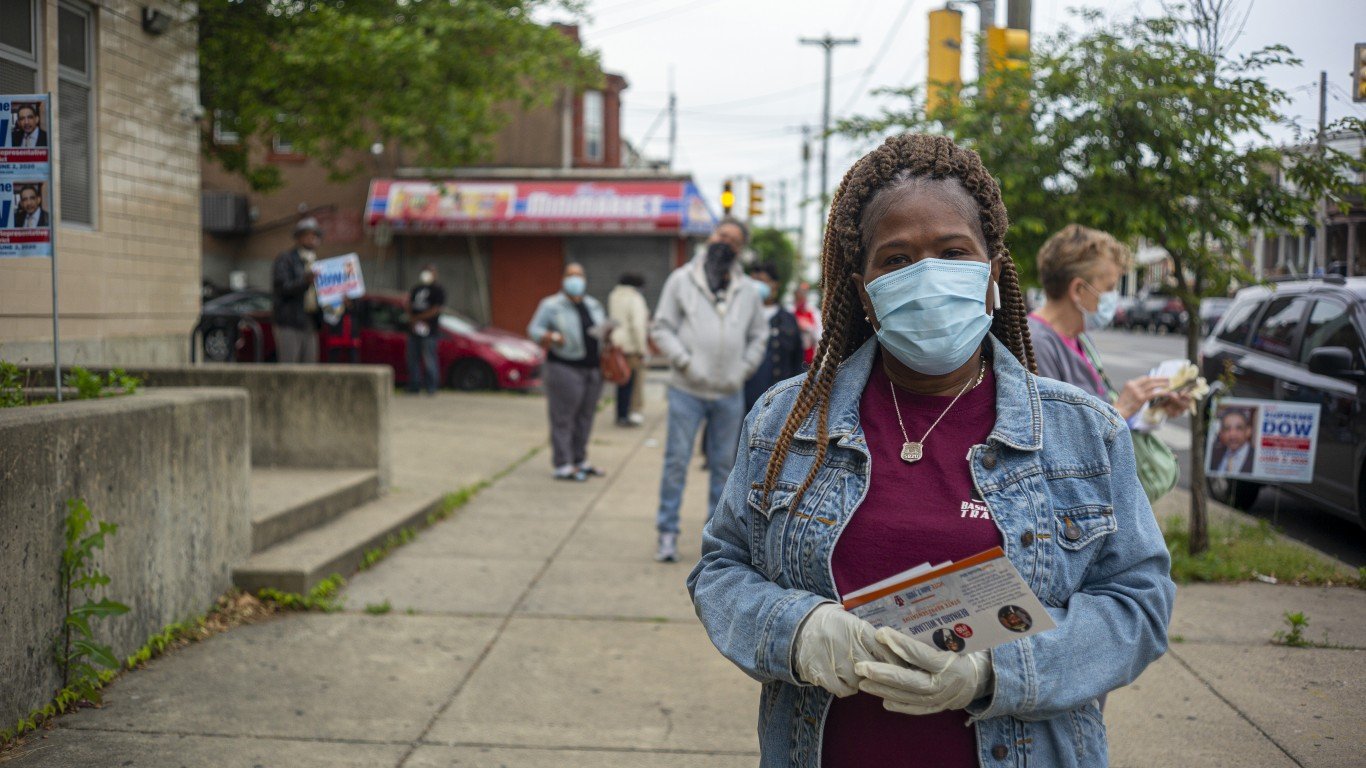
Pennsylvania
> Cumulative COVID-19 cases as of July 9: 720 per 100,000 people — 22nd lowest (total: 92,148)
> COVID-19-related deaths as of July 9: 53 per 100,000 people — 11th highest (total: 6,812)
> Total tests administered as of July 9: N/A
> Change in trailing 7-day avg. daily cases, June 1 – July 8: 5.6% — 12th smallest increase (from 87,242 to 92,148)
> Population: 12,807,060
The stay-at-home order expired on June 4 for all counties. As of July 3, Pennsylvania was in a green phase of reopening, which is the third phase of easing restrictions on businesses and movement. Businesses can increase capacity to 75%, up from 50% under the yellow phase. Child care facilities can also reopen. Large gatherings are allowed but cannot exceed 250 people. Personal care services can open at 50% capacity and only by appointment. Entertainment venues are allowed to open at 50% as well. People are required to wear a mask when in public.
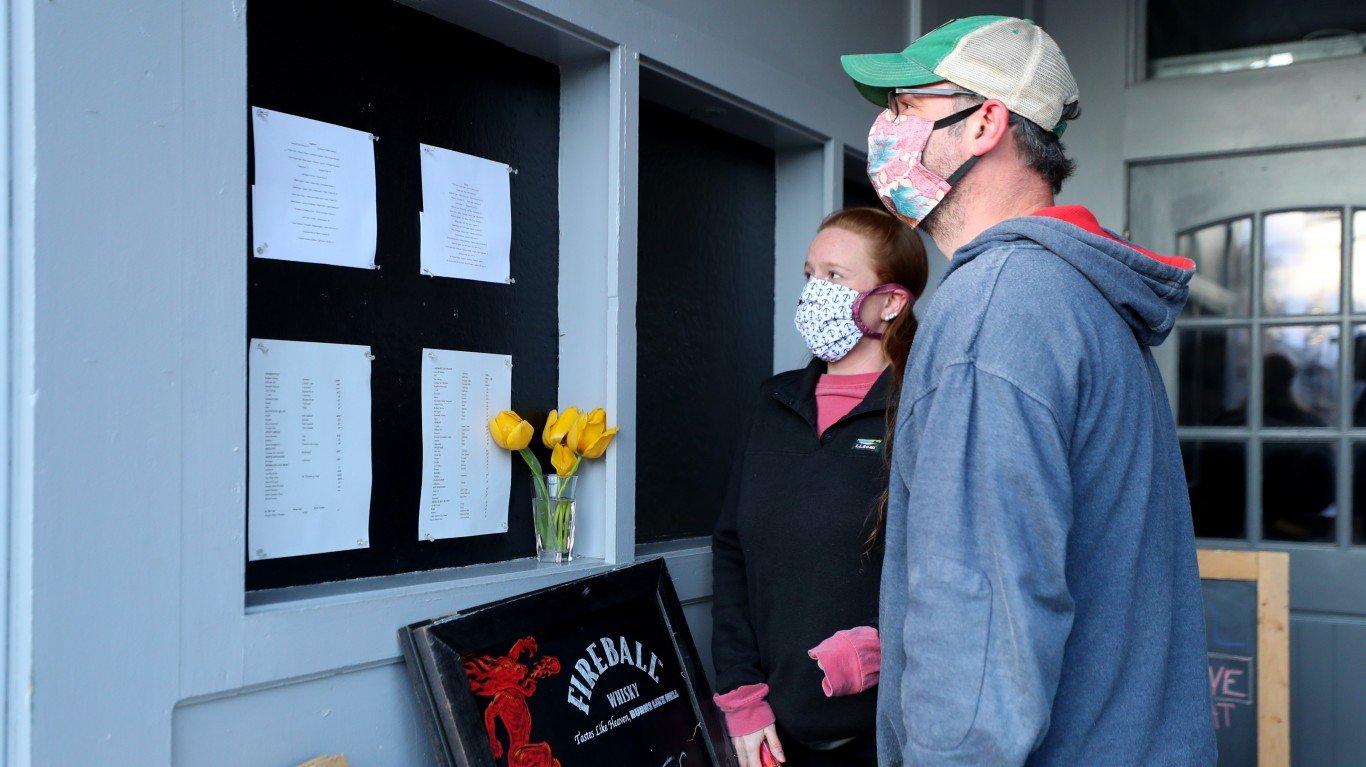
Rhode Island
> Cumulative COVID-19 cases as of July 9: 1,627 per 100,000 people — 3rd highest (total: 17,204)
> COVID-19-related deaths as of July 9: 92 per 100,000 people — 5th highest (total: 971)
> Total tests administered as of July 9: 24,989 per 100,000 people — the highest (total: 264,216)
> Change in trailing 7-day avg. daily cases, June 1 – July 8: 1.3% — 5th smallest increase (from 16,976 to 17,204)
> Population: 1,057,315
The stay-at-home order expired on May 8. People are required to wear masks indoors as well as outdoors if they can’t maintain 6 feet of distance. The state has been in phase 3 of reopening since June 30. Social gatherings are now limited to 25 people indoors and 50 people outdoors. Weddings at venues can have 50 guests indoors and 100 people outdoors. Indoor venues that were operating at limited capacity during phase 2 can expand to 66% capacity as long as 6-foot spacing is maintained.
Malls, hair salons, barbershops, and other businesses that offer personal services can reopen with restrictions. Gyms, fitness studios, and small group fitness classes are allowed to reopen but with limited capacity. Child care services can now reopen but in small groups. Summer camps and other youth summer programs started on June 29.
[in-text-ad-2]

South Carolina
> Cumulative COVID-19 cases as of July 9: 962 per 100,000 people — 16th highest (total: 48,909)
> COVID-19-related deaths as of July 9: 17 per 100,000 people — 24th lowest (total: 884)
> Total tests administered as of July 9: N/A
> Change in trailing 7-day avg. daily cases, June 1 – July 8: 29.0% — 6th biggest increase (from 37,919 to 48,909)
> Population: 5,084,127
The stay-at-home order expired on May 4. Orders for out-of-state visitors to quarantine have also expired. Though the state of emergency order was extended, occupancy limits on retail businesses have been lifted. Bowling alleys are now open, but customers should bring their own bowling balls and shoes if possible. Traveling restrictions on visitors from high-risk areas have been lifted as well.
Residents are encouraged, but are no longer required by law, to work from home. Restaurants can choose to reopen for limited dine-in services if they follow state guidelines. Outdoor customer dining services are also allowed. Youth and adult sports leagues started practicing on May 30, and competitions are now permitted. Day camps can operate provided they comply with health and safety guidelines such as campers following physical distancing per groups.
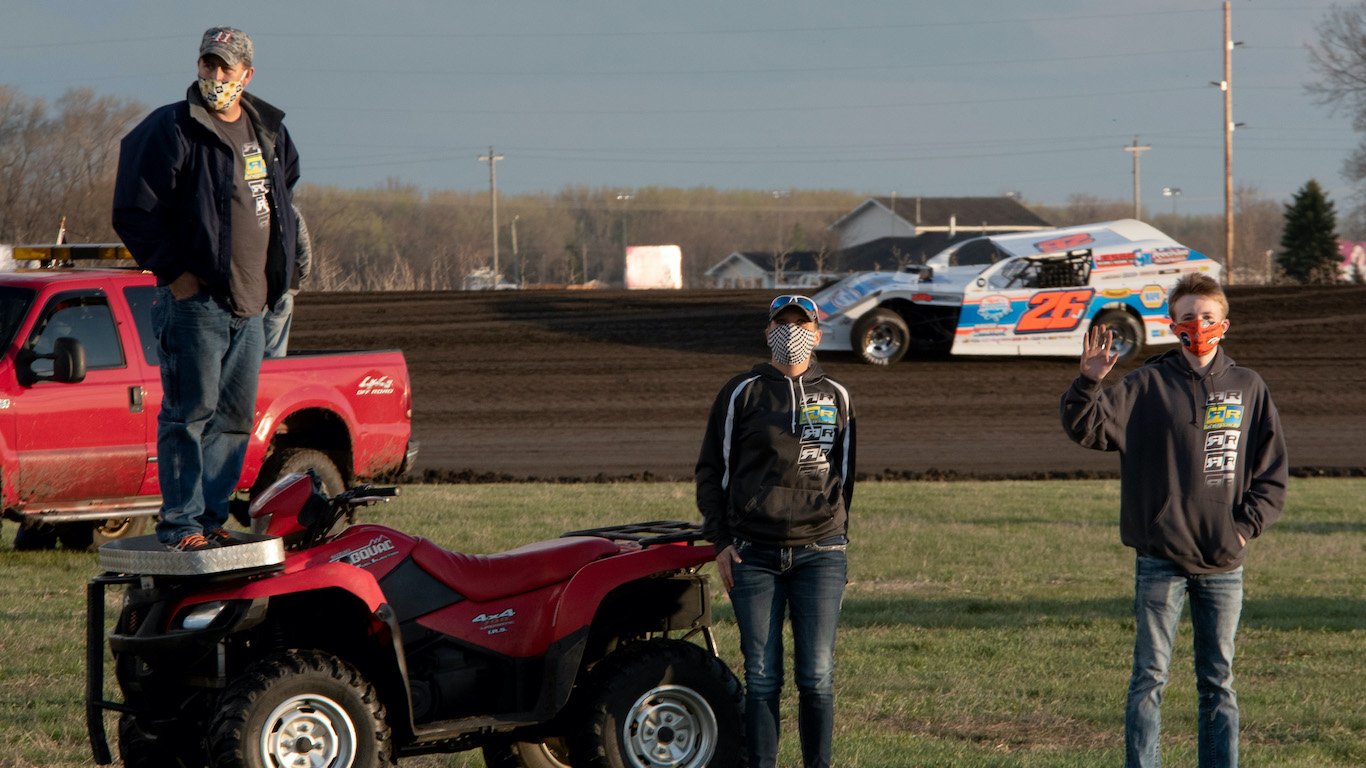
South Dakota
> Cumulative COVID-19 cases as of July 9: 821 per 100,000 people — 21st highest (total: 7,242)
> COVID-19-related deaths as of July 9: 11 per 100,000 people — 16th lowest (total: 98)
> Total tests administered as of July 9: 9,774 per 100,000 people — 24th lowest (total: 86,226)
> Change in trailing 7-day avg. daily cases, June 1 – July 8: 6.1% — 15th smallest increase (from 6,826 to 7,242)
> Population: 882,235
The state never issued a statewide stay-at-home order, but it did institute some restrictions on gatherings and businesses. An order that required state residents to observe social distancing and CDC-recommended hygiene practices expired on May 31, but the state of emergency has been extended until Dec. 30.
Businesses are now allowed to reopen if the surrounding area has reported a downward trend in cases for two weeks. Employees can now be called back to the office, though administrative leave is allowed for those who cannot come in and cannot work remotely.
[in-text-ad]

Tennessee
> Cumulative COVID-19 cases as of July 9: 827 per 100,000 people — 20th highest (total: 55,986)
> COVID-19-related deaths as of July 9: 10 per 100,000 people — 13th lowest (total: 685)
> Total tests administered as of July 9: 14,040 per 100,000 people — 10th highest (total: 950,540)
> Change in trailing 7-day avg. daily cases, June 1 – July 8: 23.5% — 11th biggest increase (from 45,315 to 55,986)
> Population: 6,770,010
The stay-at-home order expired on April 30. A safer-at-home order was in effect until May 29. Many businesses have been allowed to open in the meanwhile. Restaurants can offer in-person but limited-capacity dining. Noncontact sports, like baseball, golf, or tennis, were allowed to resume on May 22, as was higher education.
Groups of up to 50 people can gather outside for social and recreational purposes if they practice social distancing. Visitation at nursing homes and other long-term care facilities resumed with restrictions on June 15.
Shelby County, which includes Memphis and is the largest county in the state, will remain in phase 2 of reopening due to a spike in daily new coronavirus cases.

Texas
> Cumulative COVID-19 cases as of July 9: 768 per 100,000 people — 24th highest (total: 220,564)
> COVID-19-related deaths as of July 9: 10 per 100,000 people — 12th lowest (total: 2,813)
> Total tests administered as of July 9: 7,870 per 100,000 people — 14th lowest (total: 2,258,708)
> Change in trailing 7-day avg. daily cases, June 1 – July 8: 31.2% — 4th biggest increase (from 168,062 to 220,564)
> Population: 28,701,845
Texas is now in phase 3 of reopening. All air travel restrictions, including mandatory quarantines for out-of-state travelers, have been lifted. Zoos and water parks are allowed to reopen with limited capacity. Amusement parks and carnivals in counties with more than 1,000 confirmed positive cases can open at 50% capacity.
As of June 25, all plans for further reopening have been halted due to a recent increase in new COVID-19 cases and hospitalizations in the state. Just like before restrictions were lifted, elective surgeries are banned to preserve bed space for coronavirus patients. Restaurants can operate at no more than 50% of their indoor capacity, down from 75%. Outdoor gatherings of 100 or more people have to first be approved by local officials. As of July 2, Texans have been required to wear face coverings when out in public in counties with a total of 20 or more cases.
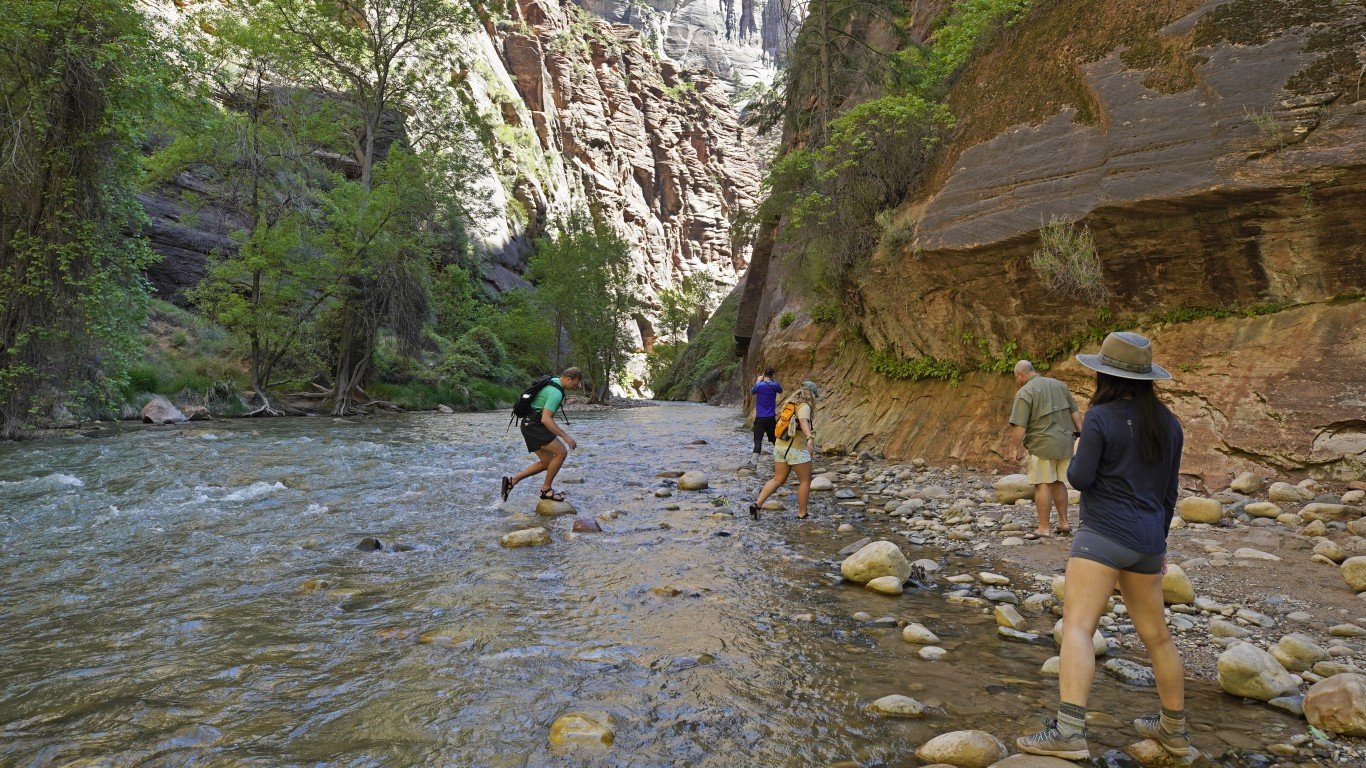
Utah
> Cumulative COVID-19 cases as of July 9: 846 per 100,000 people — 18th highest (total: 26,755)
> COVID-19-related deaths as of July 9: 6 per 100,000 people — 8th lowest (total: 201)
> Total tests administered as of July 9: 12,203 per 100,000 people — 16th highest (total: 385,760)
> Change in trailing 7-day avg. daily cases, June 1 – July 8: 14.6% — 24th biggest increase (from 22,716 to 26,033)
> Population: 3,161,105
The state never issued a statewide stay-at-home order. The stay safe, stay home directive expired on May 1. In-restaurant dining, gyms, and salons can now open. Gatherings of up to 20 people are allowed. Malls and national parks can reopen under tight restrictions. People are still encouraged to avoid nonessential travel.
Gov. Gary Herbert said on June 24 that Utah would not be considering applications by counties to ease more restrictions until July 8 due to an increase in new coronavirus cases in the state. Most of the state is still in the yellow (or low-risk) phase of reopening. In this phase, all economic activities are allowed if people practice social distancing and proper hygiene.
[in-text-ad-2]
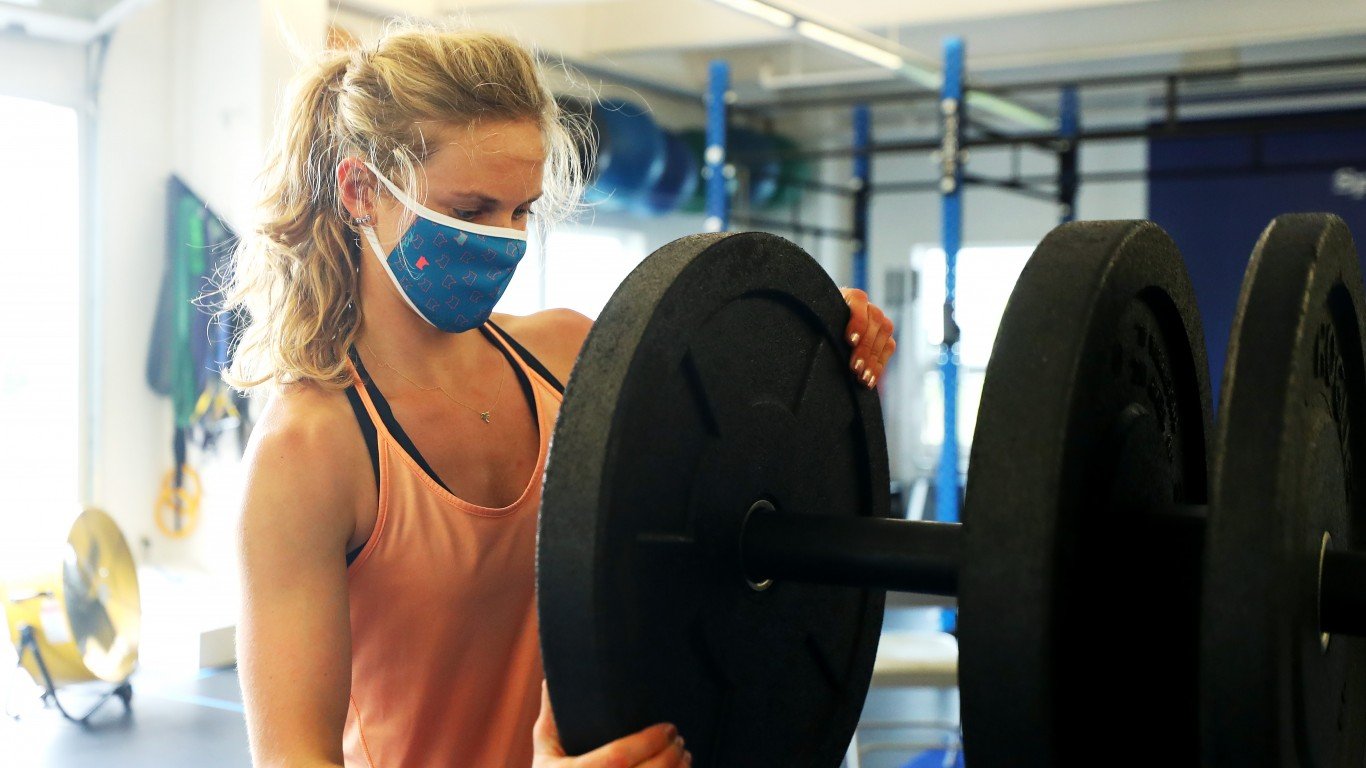
Vermont
> Cumulative COVID-19 cases as of July 9: 201 per 100,000 people — 4th lowest (total: 1,256)
> COVID-19-related deaths as of July 9: 9 per 100,000 people — 10th lowest (total: 56)
> Total tests administered as of July 9: 11,457 per 100,000 people — 19th highest (total: 71,756)
> Change in trailing 7-day avg. daily cases, June 1 – July 8: 3.8% — 8th smallest increase (from 1,210 to 1,256)
> Population: 626,299
The stay-at-home order expired on May 15. As of June 17, Vermont residents aged 65 and older were no longer required to stay at home. Retail and lodging businesses have reopened. Hair salons and barbershops can reopen but by appointment and with limits on occupancy. Transactions must be cashless and touchless, and owners must keep a customer log in case contact tracing is needed later.
Travel restrictions have been loosened. Out-of-state visitors can visit Vermont, but they have to complete a 14-day quarantine or a seven-day quarantine if they present a negative test result taken in their home state or in Vermont.
Events can have up to 75 people indoors and up to 150 outdoors. Arts, culture, and entertainment venues, as well as restaurants, can expand capacity to 50% or one person per 100 square feet.
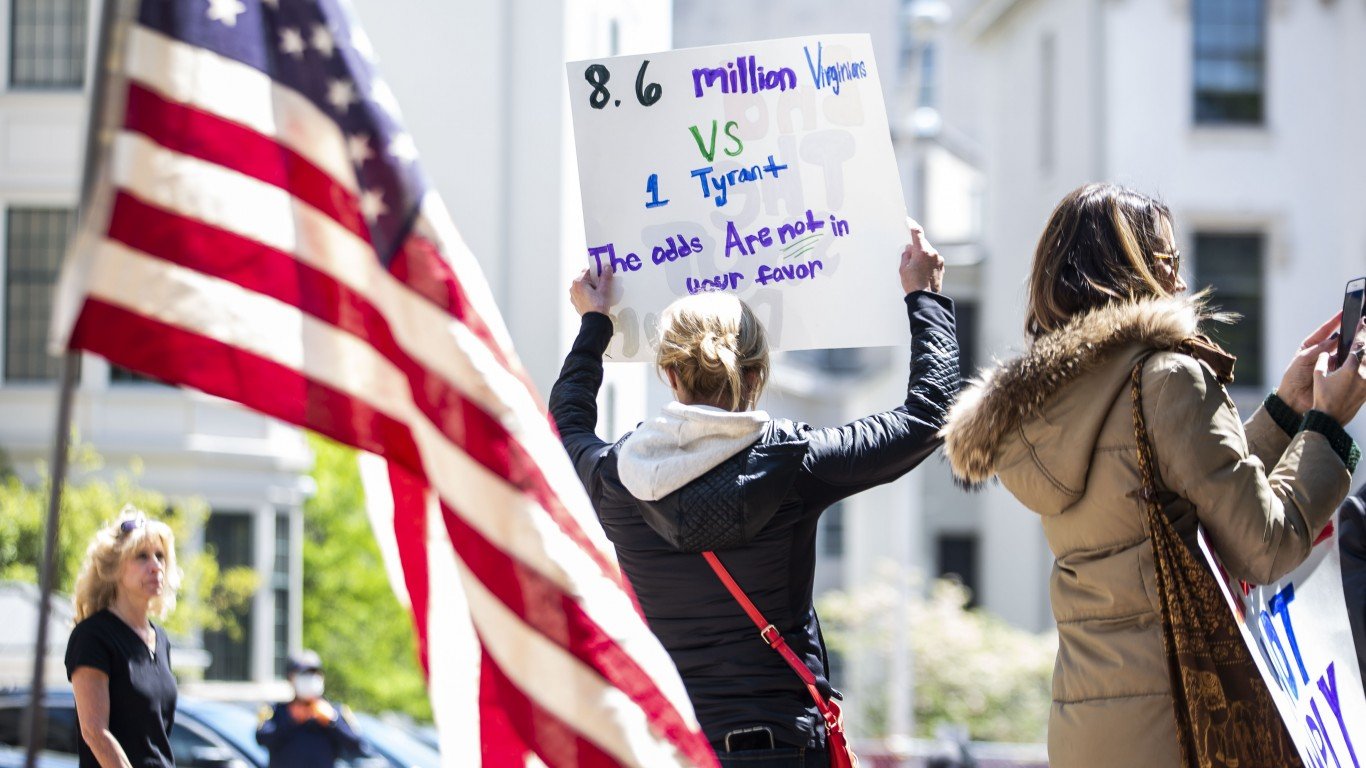
Virginia
> Cumulative COVID-19 cases as of July 9: 798 per 100,000 people — 23rd highest (total: 67,988)
> COVID-19-related deaths as of July 9: 23 per 100,000 people — 22nd highest (total: 1,937)
> Total tests administered as of July 9: 8,813 per 100,000 people — 18th lowest (total: 750,631)
> Change in trailing 7-day avg. daily cases, June 1 – July 8: 6.6% — 17th smallest increase (from 63,203 to 67,375)
> Population: 8,517,685
A stay-at-home order was in effect until June 10. The state is currently in phase 3 of reopening. Social distancing and face coverings are still required. Social gathering limits are limited to 250 people or 50% of occupancy, whichever is less. Fitness centers can open indoor areas at 75% occupancy. Recreation and entertainment venues may operate at 50% capacity or a maximum of 1,000 people. Overnight summer camps will remain closed. Bars and restaurants may not allow patrons to congregate in areas such as the bar seating or waiting areas.
[in-text-ad]
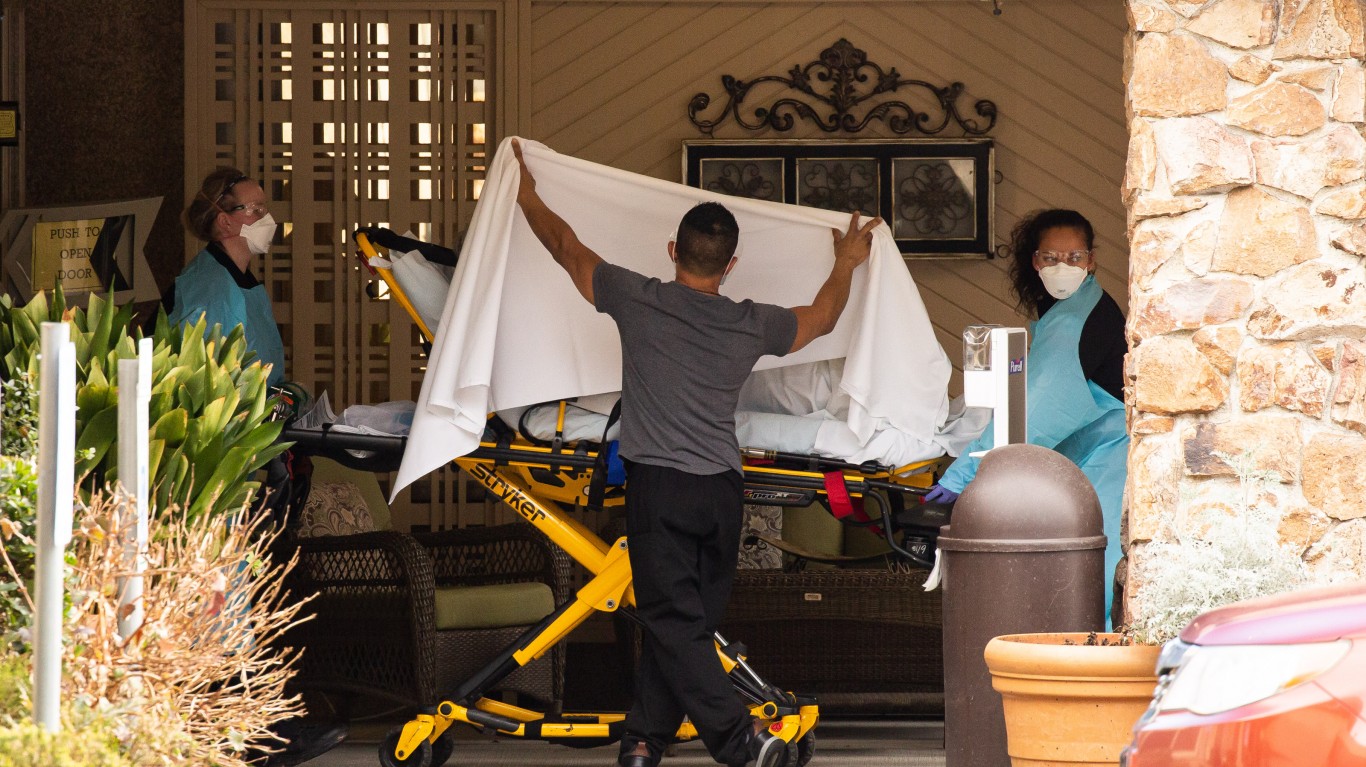
Washington
> Cumulative COVID-19 cases as of July 9: 503 per 100,000 people — 13th lowest (total: 37,941)
> COVID-19-related deaths as of July 9: 18 per 100,000 people — 25th highest (total: 1,394)
> Total tests administered as of July 9: 8,560 per 100,000 people — 16th lowest (total: 645,072)
> Change in trailing 7-day avg. daily cases, June 1 – July 8: 14.0% — 25th smallest increase (from 32,824 to 37,420)
> Population: 7,535,591
A stay-at-home, stay healthy order was in effect until May 31 and has been replaced since by a Safe Start reopening plan, which was extended until Aug. 6. Gov. Jay Inslee announced on June 27 that the state was putting on hold plans to move to phase 4 of reopening, which would have meant even fewer restrictions on businesses and people’s movement.
In phase 3, people are allowed to gather outside in groups of no more than 50 people and nonessential travel can resume. Also, recreational facilities can open at 50% capacity, restaurants can expand capacity to 75% capacity, bars can open at 25% capacity, and movie theaters can open at 50% capacity.
As of Friday, June 26, face coverings have been be required when in public across Washington state.
West Virginia
> Cumulative COVID-19 cases as of July 9: 208 per 100,000 people — 5th lowest (total: 3,751)
> COVID-19-related deaths as of July 9: 5 per 100,000 people — 5th lowest (total: 95)
> Total tests administered as of July 9: 10,851 per 100,000 people — 22nd highest (total: 195,955)
> Change in trailing 7-day avg. daily cases, June 1 – July 8: 23.3% — 12th biggest increase (from 2,932 to 3,615)
> Population: 1,805,832
State residents are encouraged but not required to stay inside. State park cabins, museums, and zoos are open. Bars can serve at 50% capacity. Spas and massage businesses are open. So are swimming pools, bowling alleys, pool halls, roller rinks, other indoor amusement venues, and movie theaters. Social gatherings in public are now limited to 100 people, up from 25.
Low-contact outdoor youth sports and little league organizations can now resume practices, and sports games can start. Sports venues and facilities can open as well. Open-air concerts, fairs, and festivals are now allowed to take place. A statewide order requiring face coverings in indoor public places took effect on July 7.
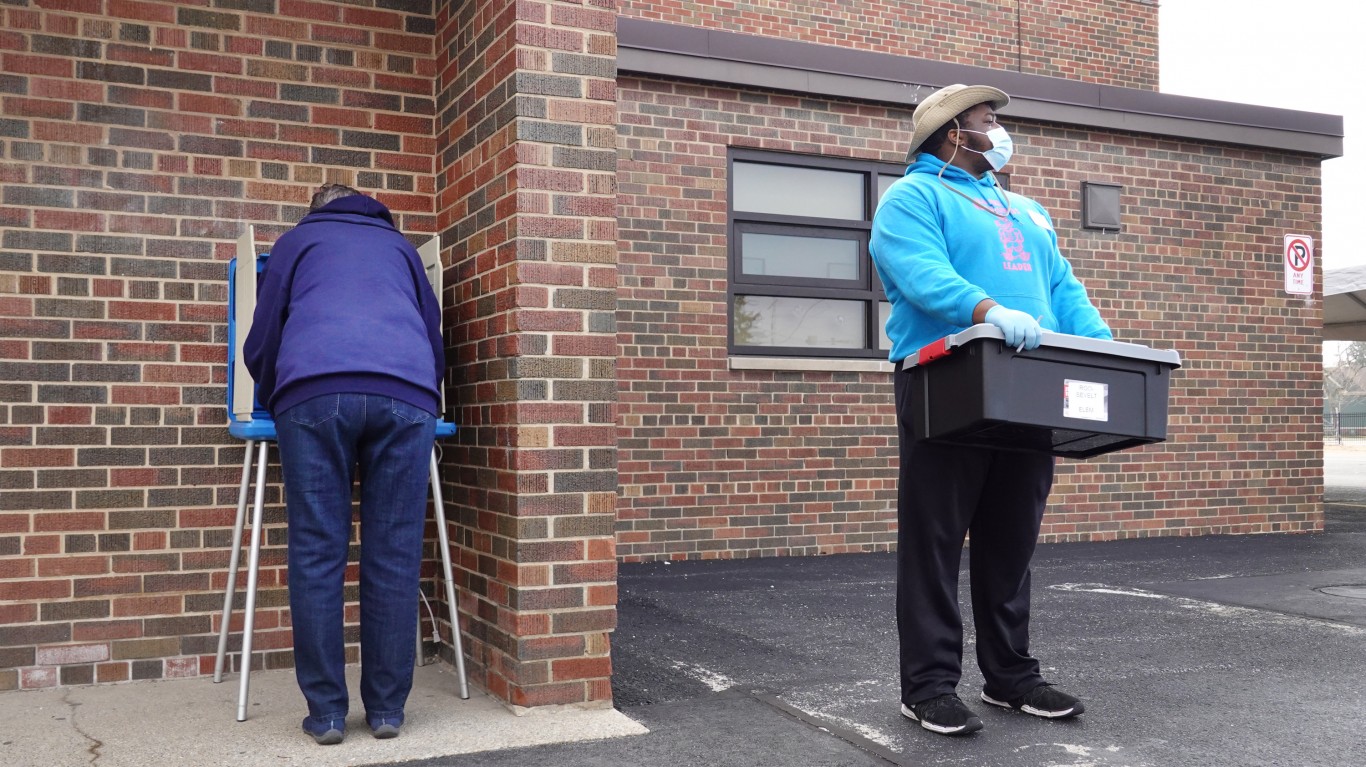
Wisconsin
> Cumulative COVID-19 cases as of July 9: 570 per 100,000 people — 17th lowest (total: 33,154)
> COVID-19-related deaths as of July 9: 14 per 100,000 people — 20th lowest (total: 807)
> Total tests administered as of July 9: N/A
> Change in trailing 7-day avg. daily cases, June 1 – July 8: 13.5% — 23rd smallest increase (from 29,199 to 33,154)
> Population: 5,813,568
The Wisconsin Supreme Court struck down the stay-at-home order that was supposed to be in effect until May 26. All restrictions were then lifted.
The state released guidelines for schools to reopen in the fall. Classes will be a combination of in-person, physically-distanced, and virtual learning. Classroom sizes will have to be reduced, which may make attending school in shifts necessary. Four-day school week — with the fifth day being designated for cleaning — is also an option.
[in-text-ad-2]
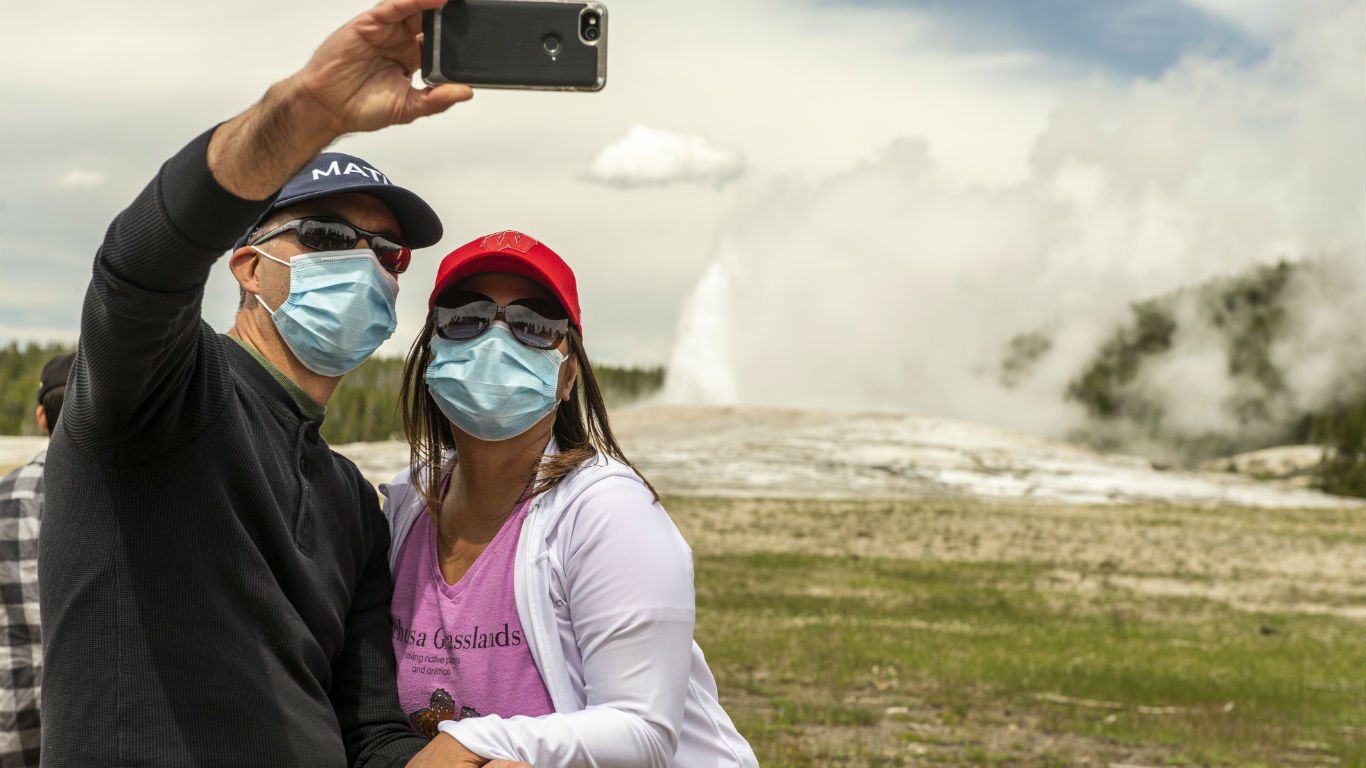
Wyoming
> Cumulative COVID-19 cases as of July 9: 301 per 100,000 people — 8th lowest (total: 1,740)
> COVID-19-related deaths as of July 9: 4 per 100,000 people — 4th lowest (total: 21)
> Total tests administered as of July 9: 6,677 per 100,000 people — 11th lowest (total: 38,577)
> Change in trailing 7-day avg. daily cases, June 1 – July 8: 15.1% — 22nd biggest increase (from 1,487 to 1,711)
> Population: 577,737
Outdoor gatherings of up to 250 people have been allowed since June 1, but people must practice social distancing. Indoor gatherings of up to 250 people are now allowed as well. Schools, community colleges, the University of Wyoming and other educational institutions can resume in-person instruction, but fitness classes cannot be of no more than 50 people.
Personal care services no longer have to operate by appointment only. Long-term care facilities can now resume outdoor, in-person visitation under specific health guidelines.
Gov. Mark Gordon announced on June 29 that the state’s existing orders and restrictions will remain unchanged at least until July 15 due to a steady increase in COVID-19 cases in the state.
Take This Retirement Quiz To Get Matched With A Financial Advisor (Sponsored)
Take the quiz below to get matched with a financial advisor today.
Each advisor has been vetted by SmartAsset and is held to a fiduciary standard to act in your best interests.
Here’s how it works:
1. Answer SmartAsset advisor match quiz
2. Review your pre-screened matches at your leisure. Check out the
advisors’ profiles.
3. Speak with advisors at no cost to you. Have an introductory call on the phone or introduction in person and choose whom to work with in the future
Take the retirement quiz right here.
Thank you for reading! Have some feedback for us?
Contact the 24/7 Wall St. editorial team.
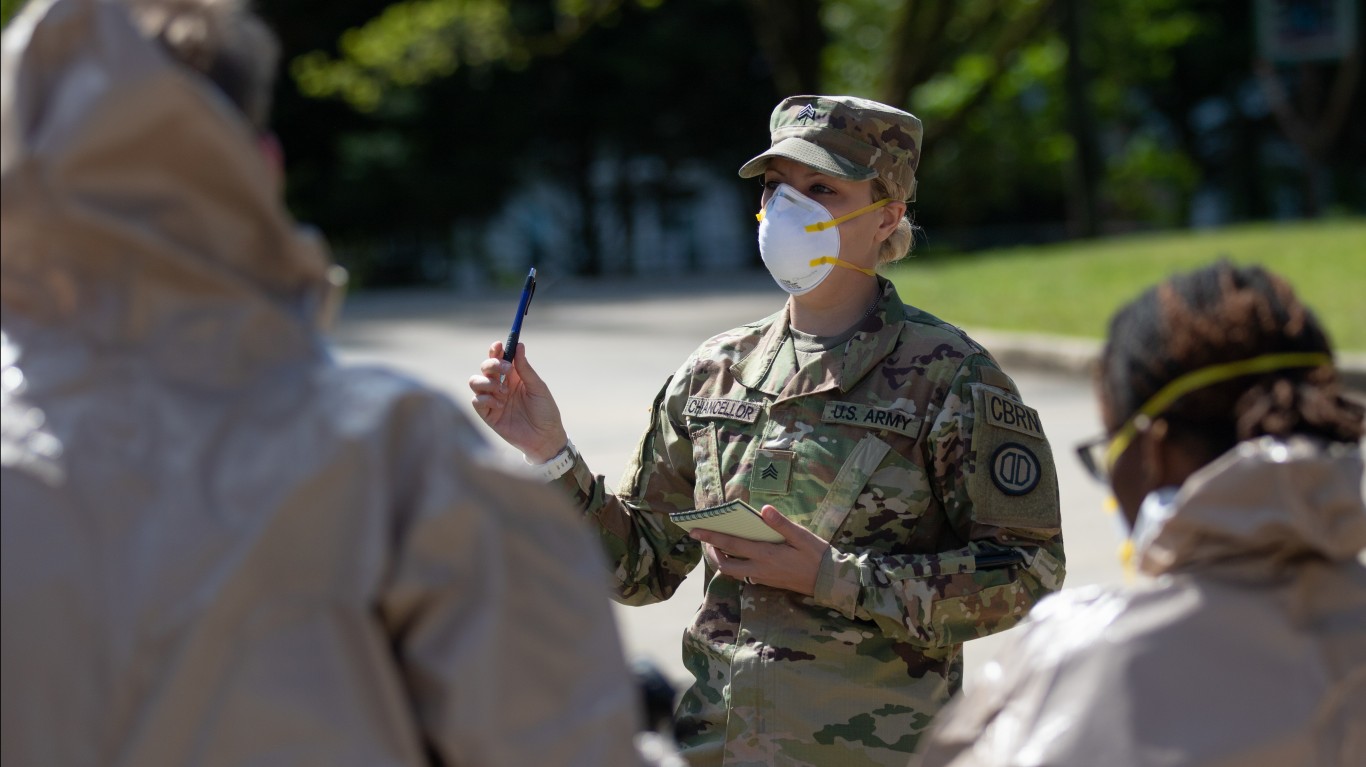
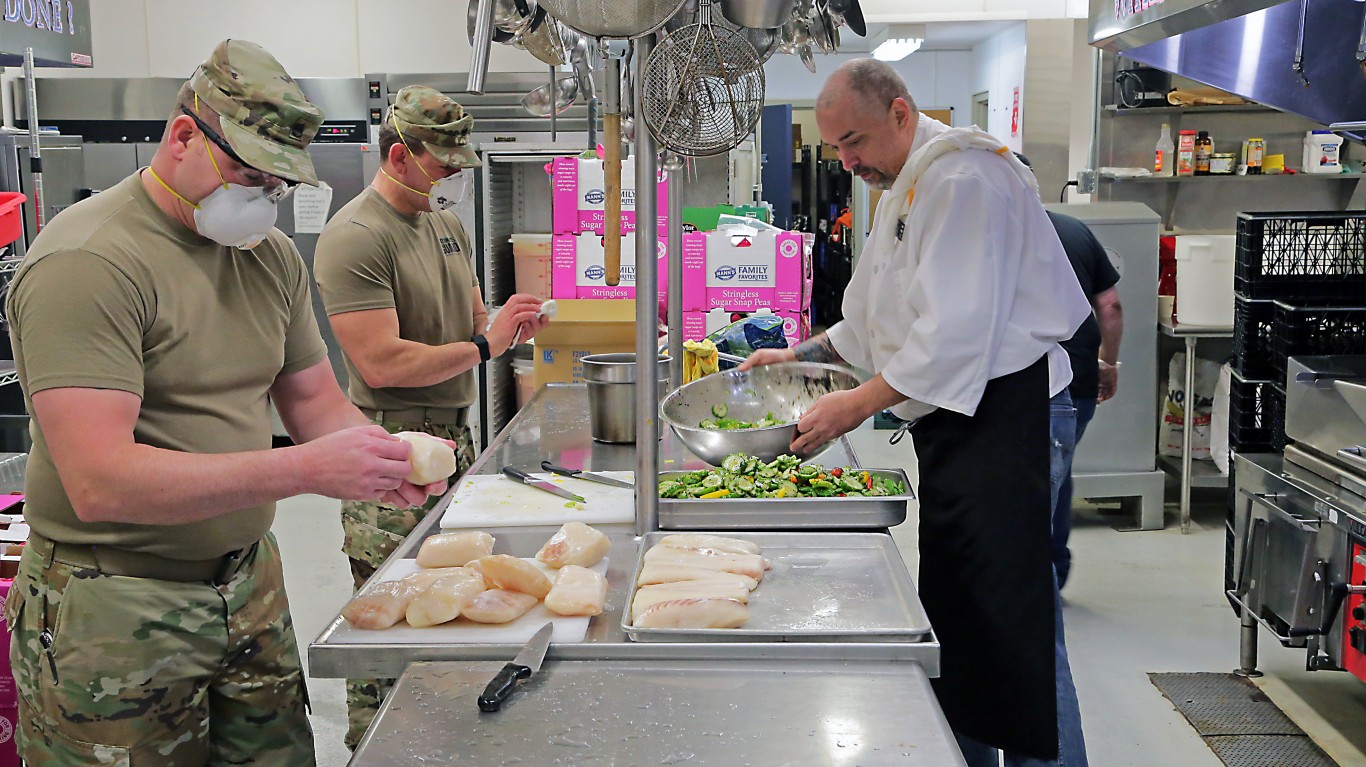
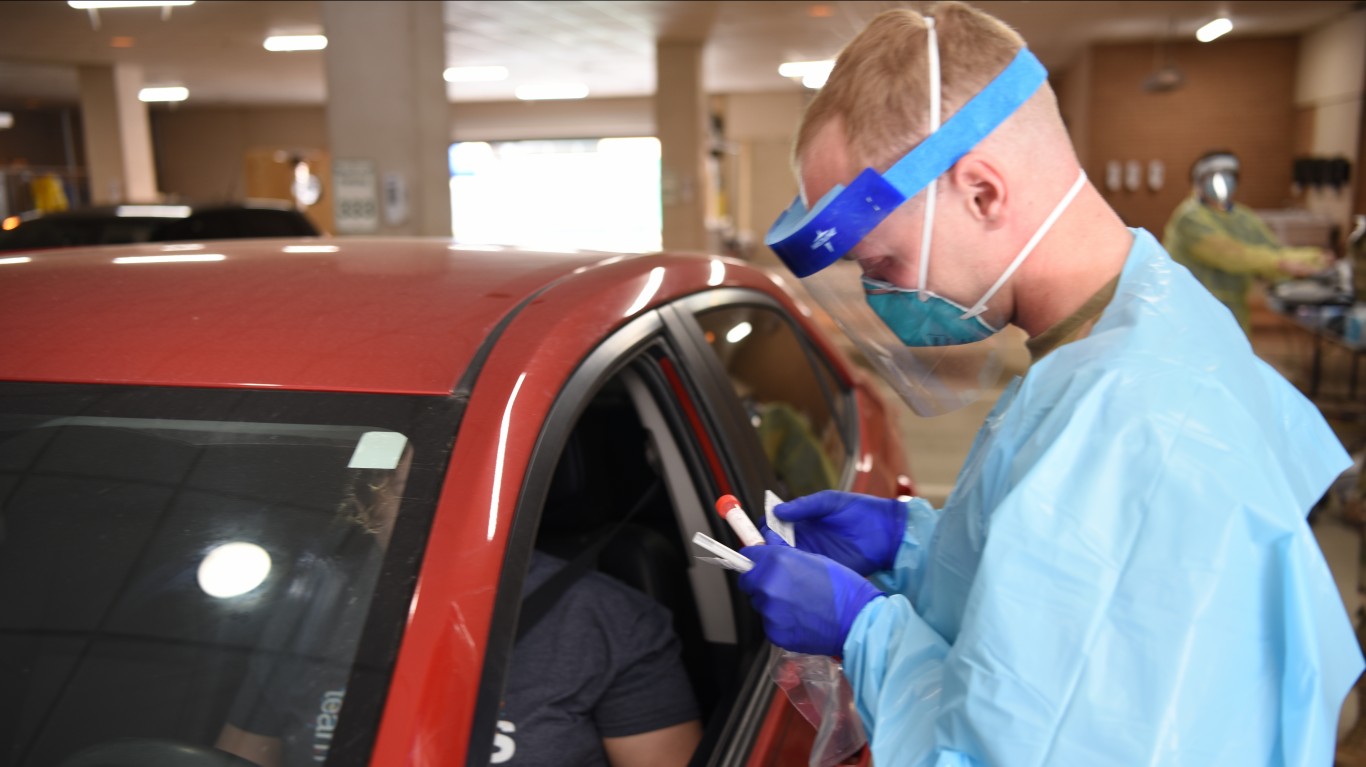
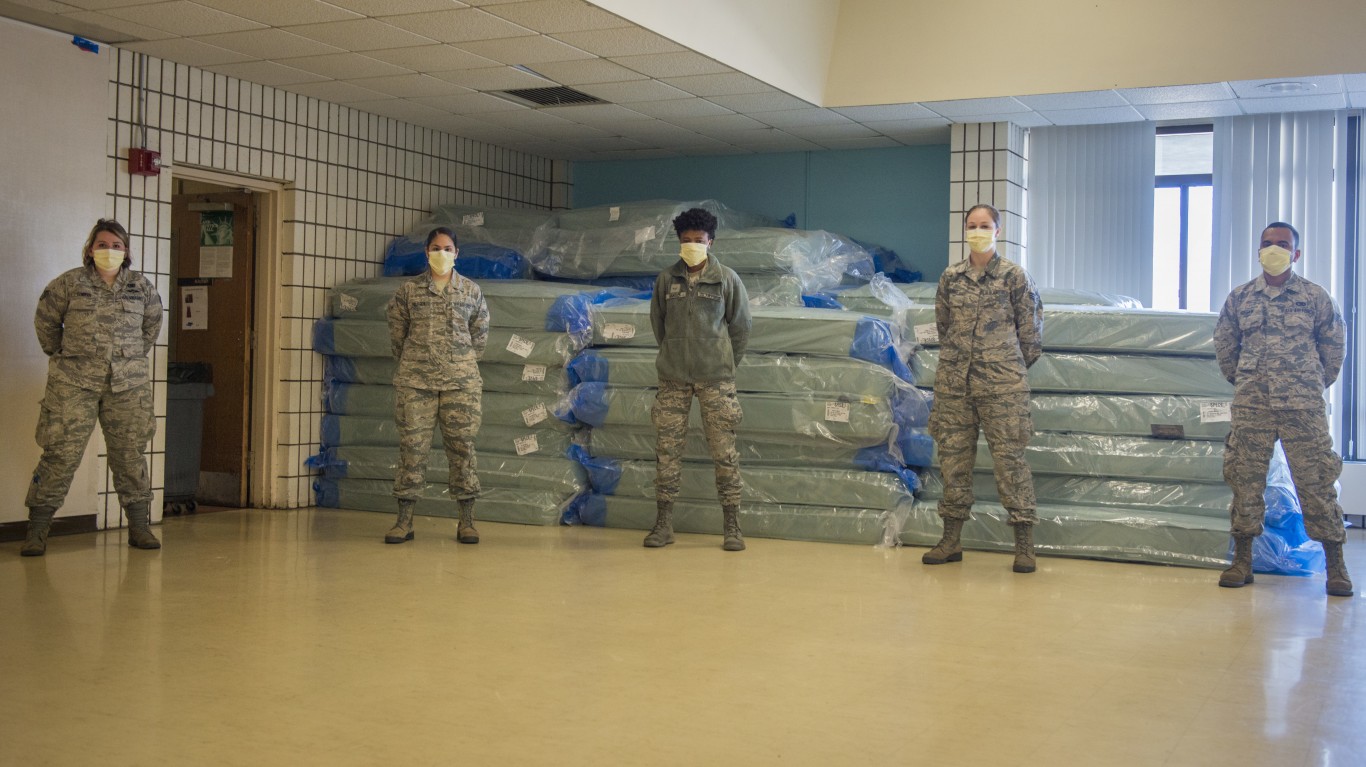
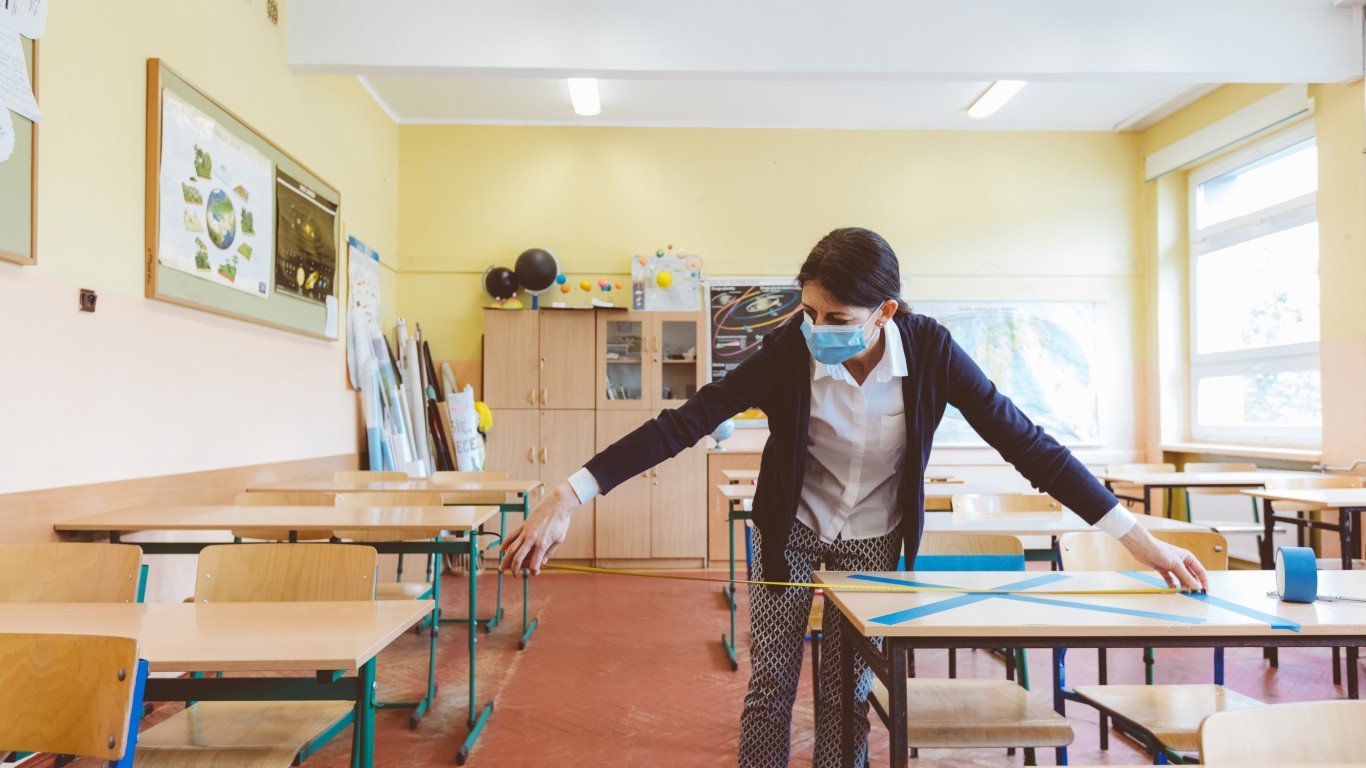 24/7 Wall St.
24/7 Wall St.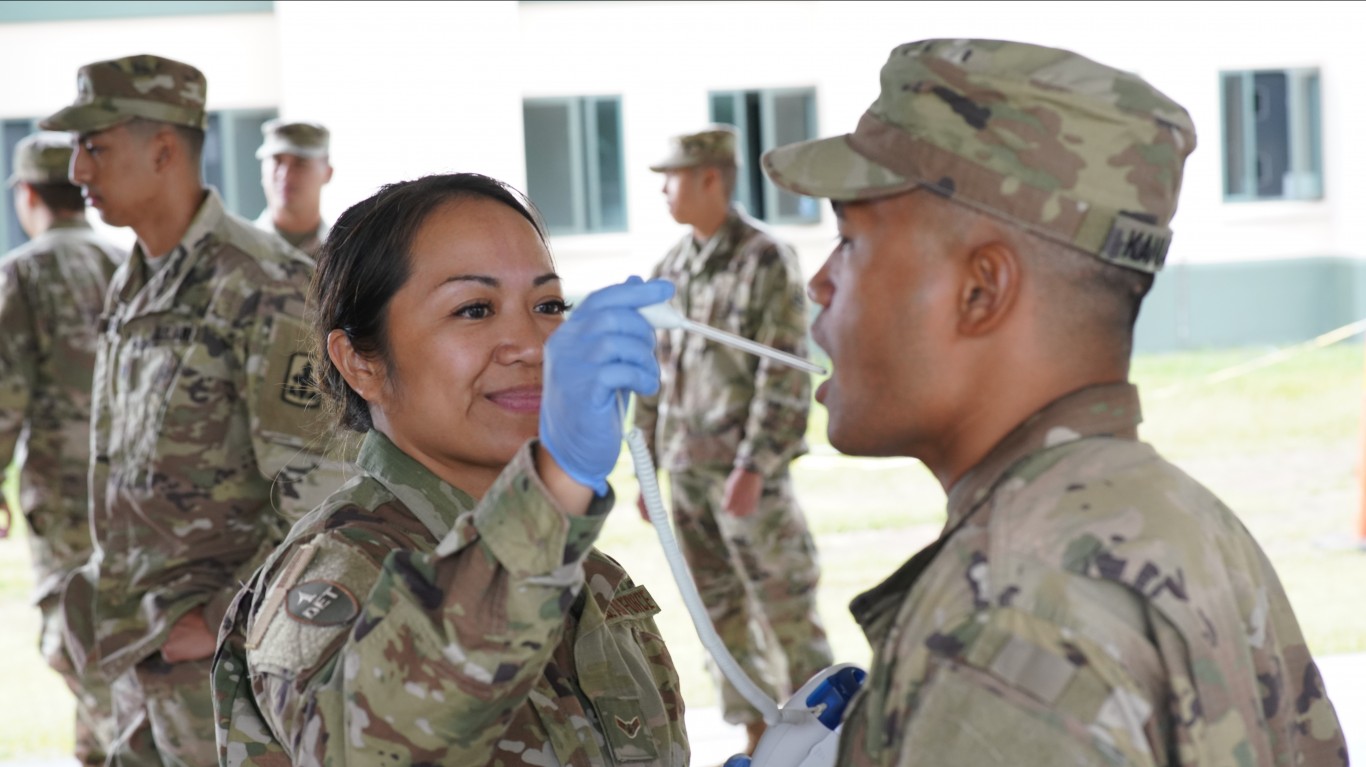
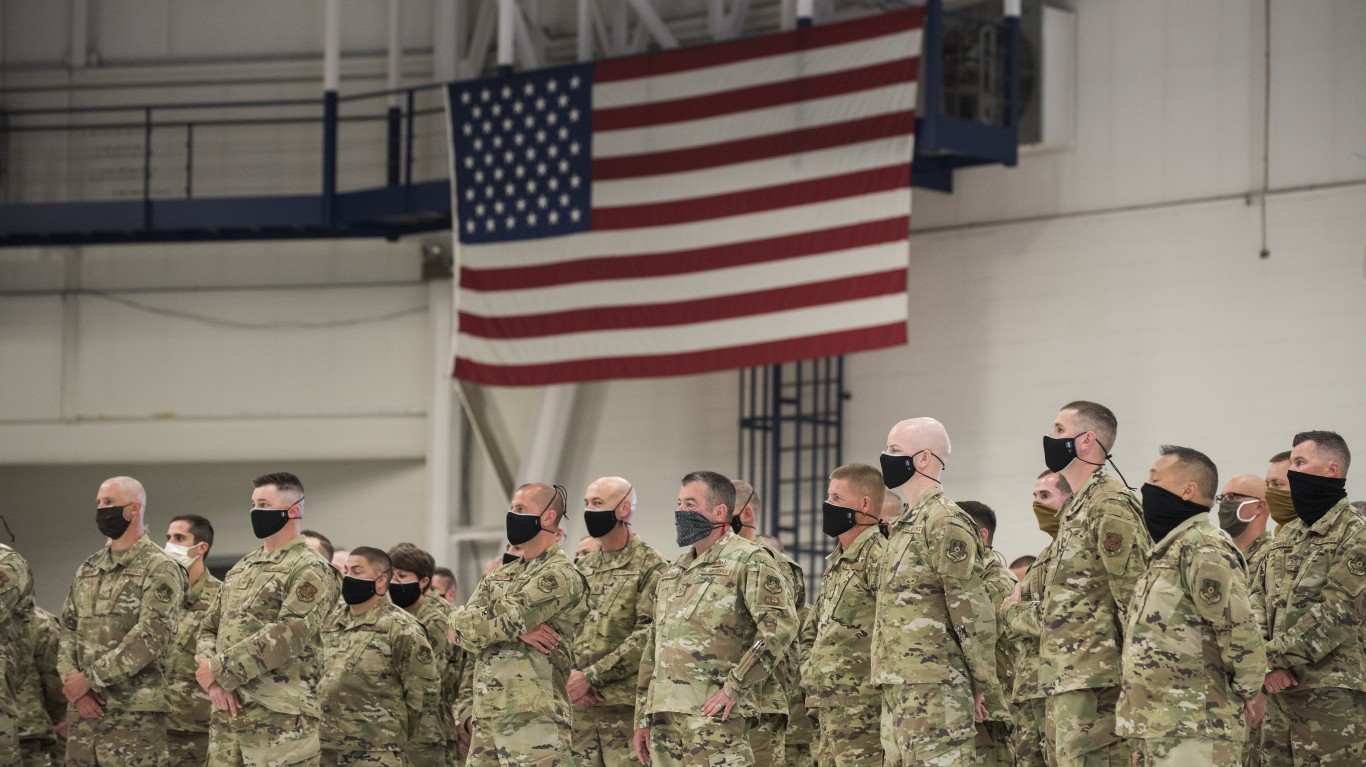

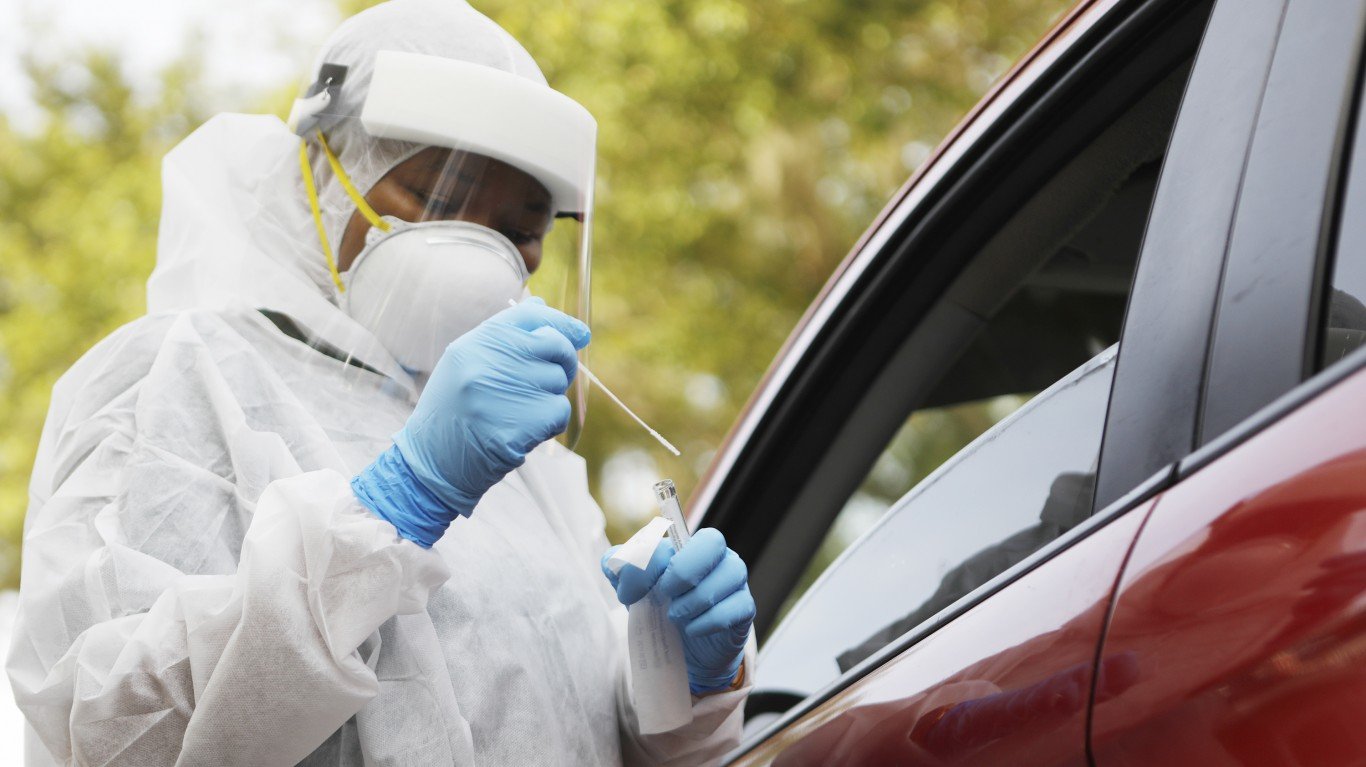 24/7 Wall St.
24/7 Wall St.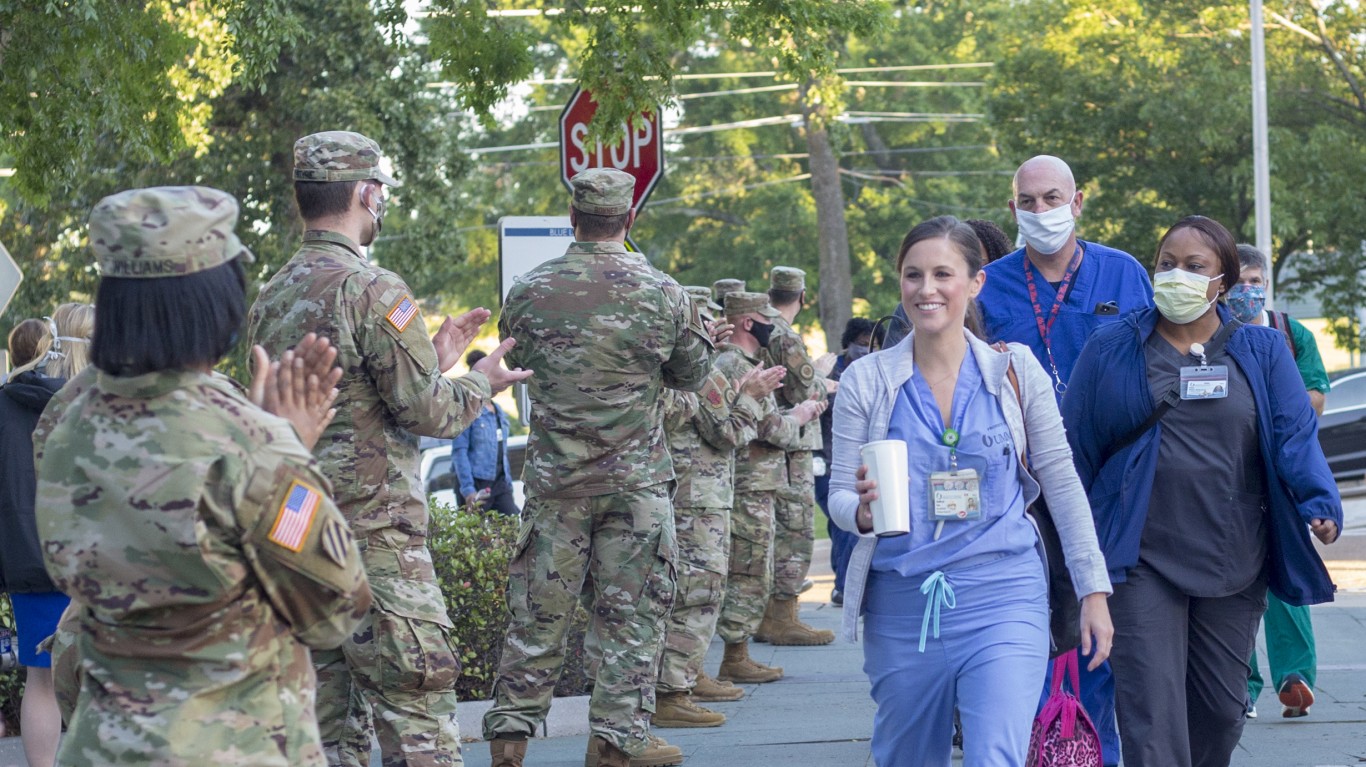

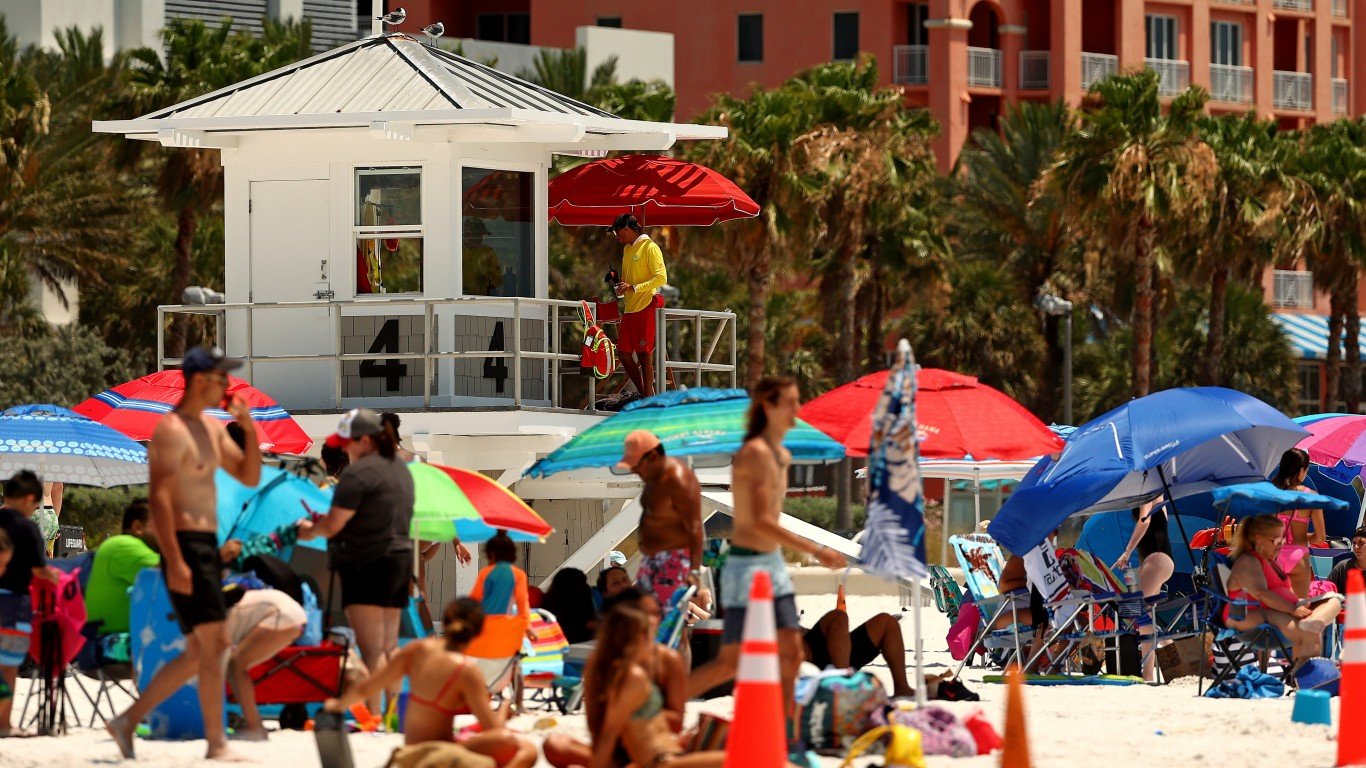 24/7 Wall St.
24/7 Wall St.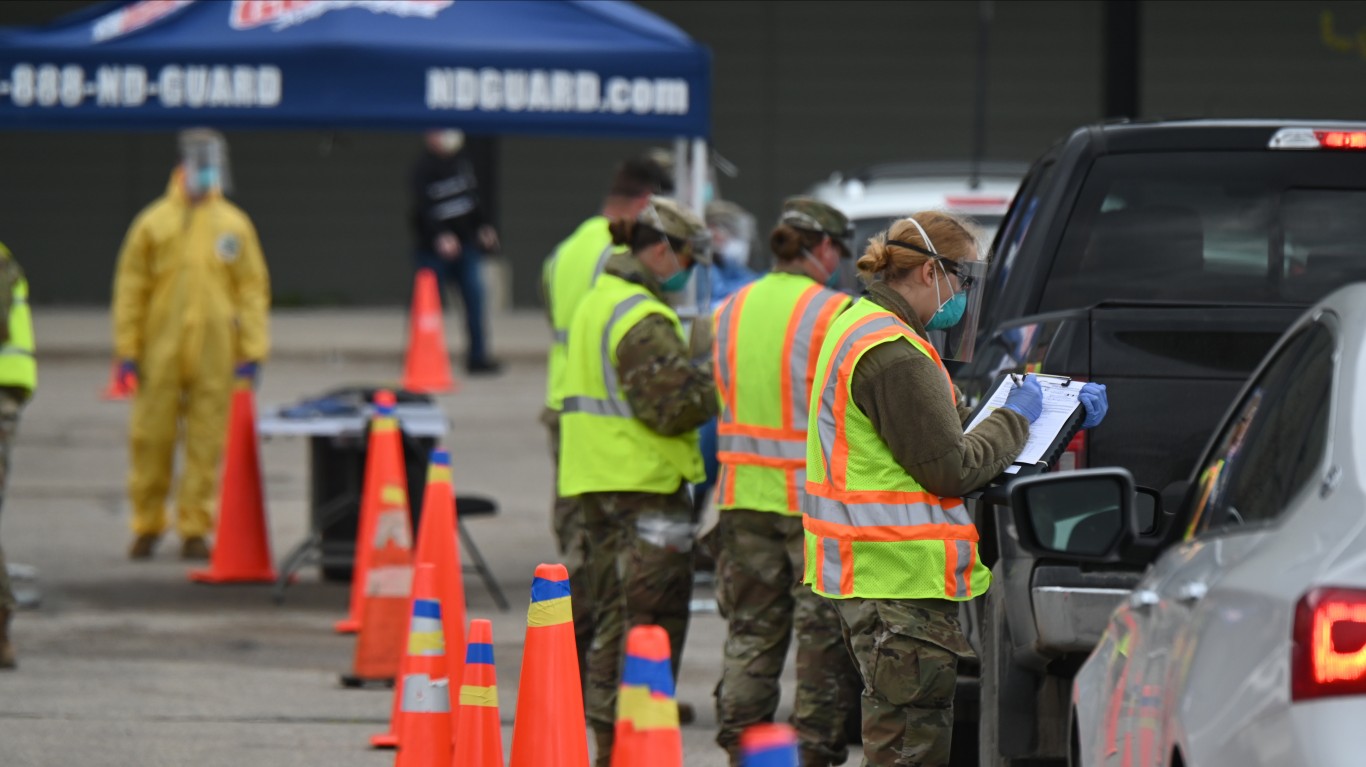
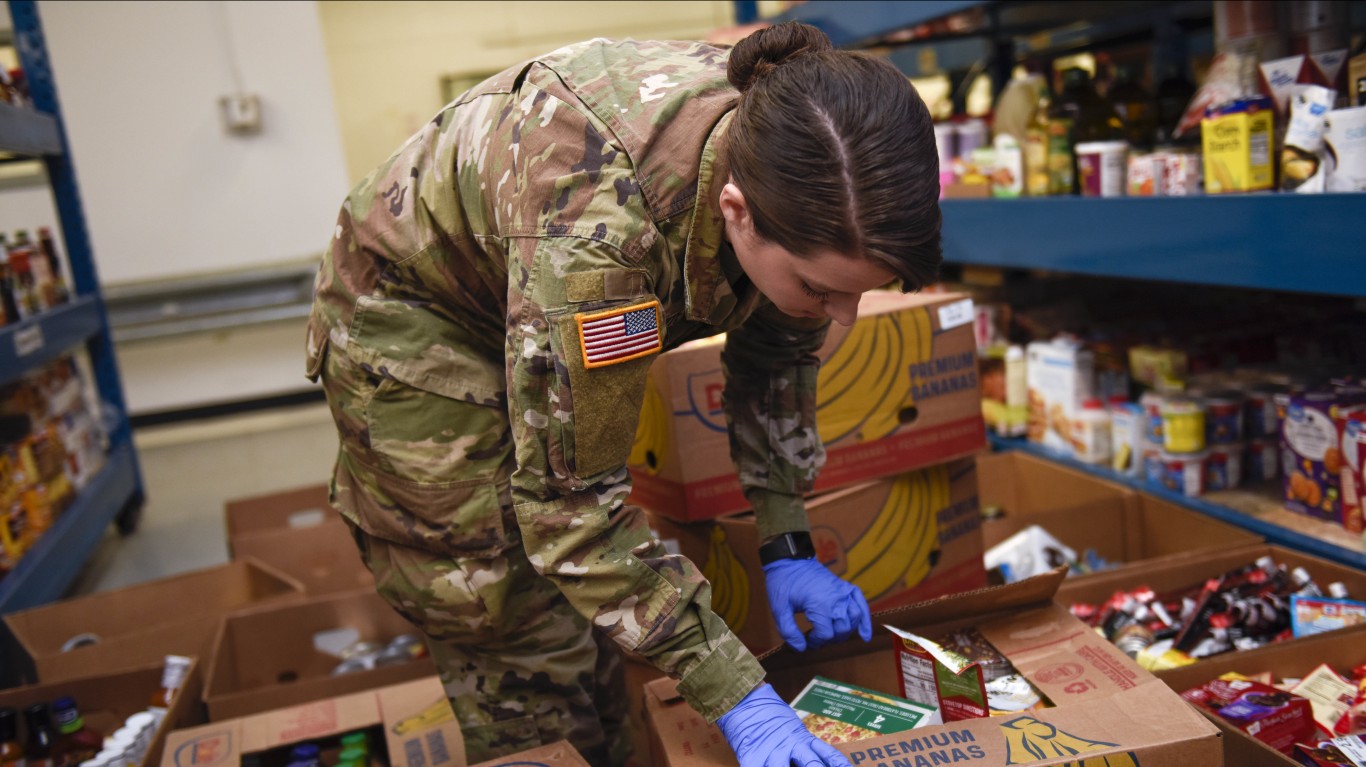
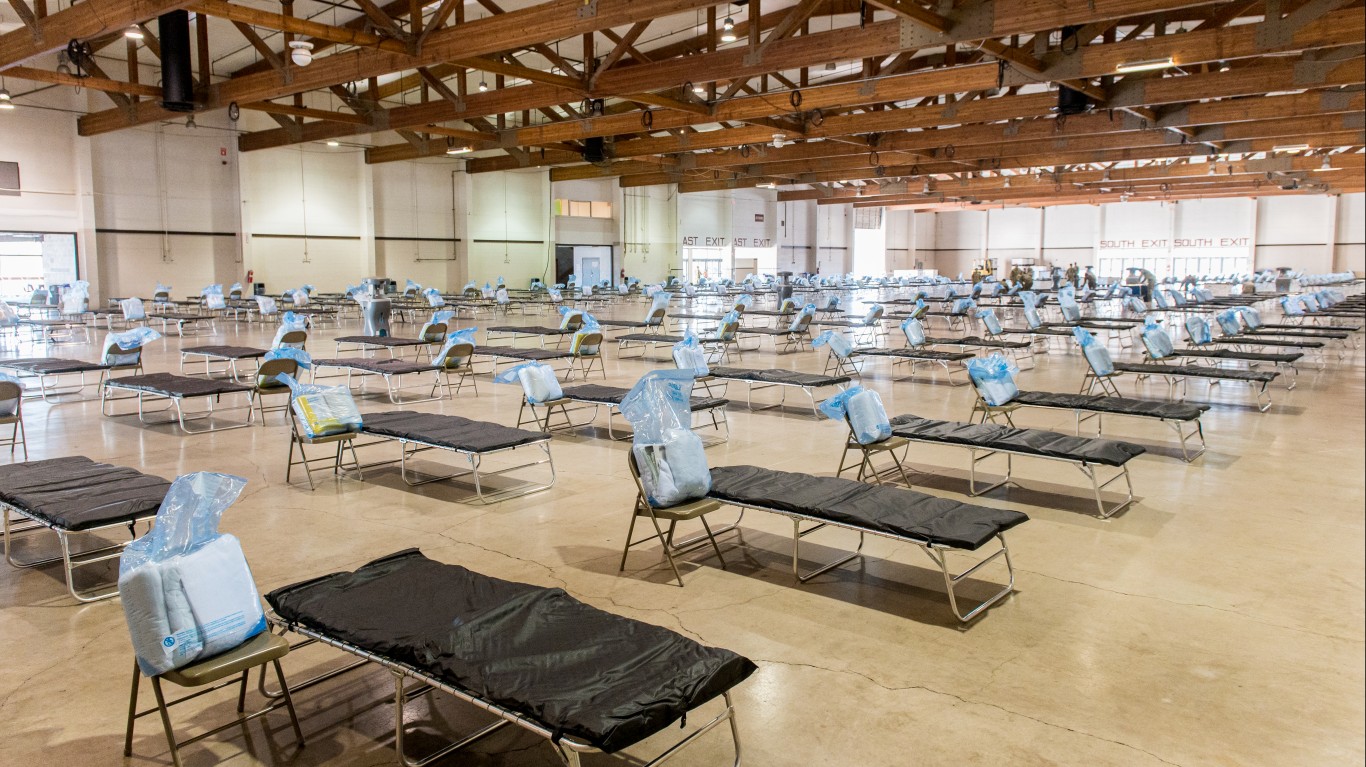
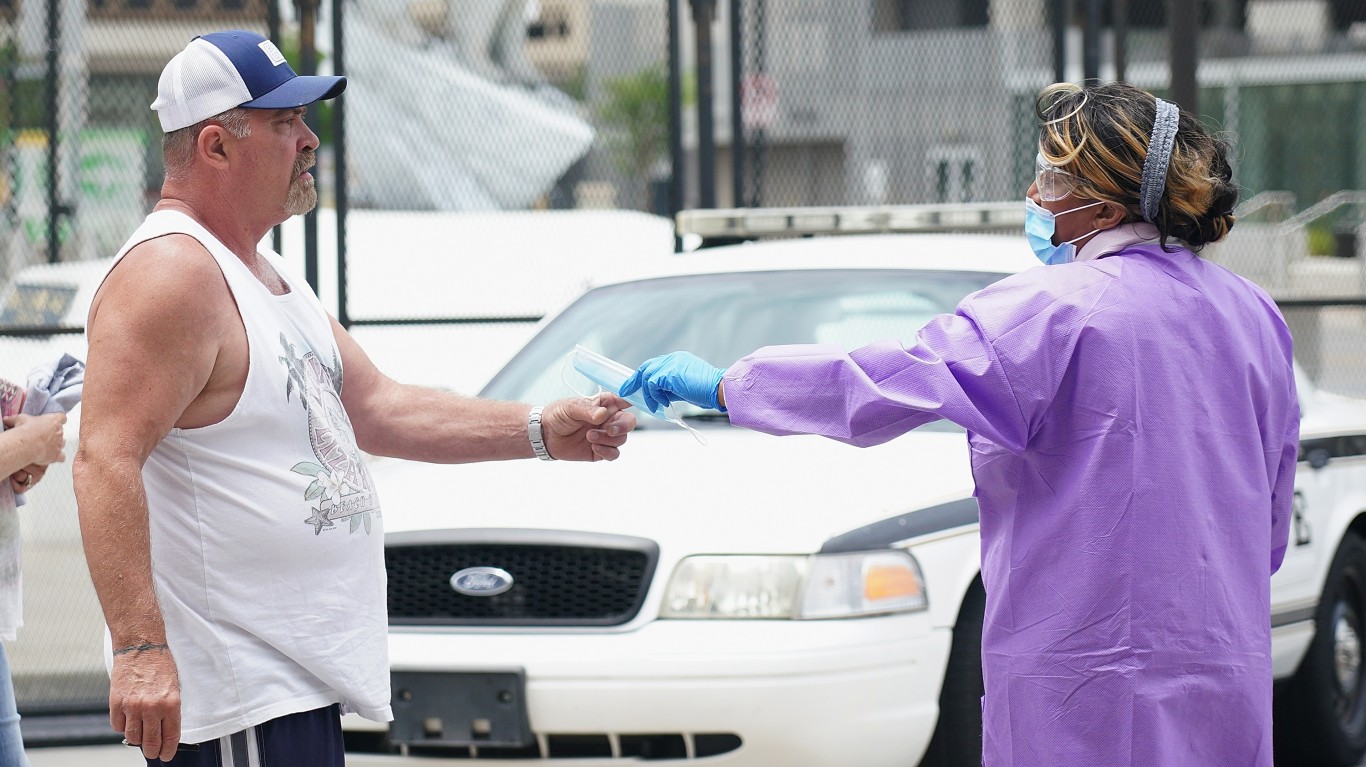 24/7 Wall St.
24/7 Wall St.